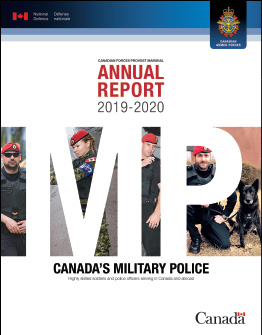Canadian Forces Provost Marshal Report - Fiscal Year 2019-2020

Office of the Canadian Forces Provost Marshal and Military Police Group Headquarters
2200 Walkley Road
Ottawa, ON, K1A 0K2
Telephone: 613-949-1000
Fax: 613 949-1637.
Catalogue No. D3-13F-PDF
ISSN 2561-8490 (Online)
Table of contents
- Message from the Canadian Forces Provost Marshal and Commander of the Canadian Forces Military Police Group
- Military Police Strategic Plan 2019-2024
- Military Police Legal Services
- Highlights
- Message from the Canadian Forces Military Police Group Chief Warrant Officer
- Annex A: Analytics and Sexual Offences
- Annex B: Investigation Statistics
- Annex C: Mission, Vision, MP Values and Core Functions
- Annex D: Structure and Jurisdiction
- Annex E: The MP in Numbers
- Annex F: Map - CF MP Gp in Canada
- Annex G: Map - MP support to CAF Named Operations
- Annex H: Map – Military Police Security Service (MPSS) Disposition
Message from the Canadian Forces Provost Marshal and Commander Canadian Forces Military Police Group

It is my pleasure to present this annual report on Military Police (MP) activities in support of the Canadian Armed Forces (CAF) and the Department of National Defence (DND) for the period from 1 April 2019 to 31 March 2020.
In my second year as Canadian Forces Provost Marshal (CFPM) and Commander Canadian Forces Military Police Group (CF MP Gp), this report presents an opportunity for me to highlight the excellent work of the men and women across the CF MP Gp who day in and day out provide professional policing, security and detention services to the CAF and DND globally, across the full spectrum of military operations.
This past year, progress was made towards the five priorities defined in the Military Police Strategic Plan 2019-2024. We have seen progress in many areas such as the creation of a Force Development cell. This newly formed element developed the implementation plan to deploy Conducted Energy Weapons (CEWs), commonly referred to as Tasers, to our frontline police personnel. In addition, we launched the MP Analytics Program (MPAP) to build a data driven and evidence based approach to the management of policing resources. The data and analytics program has additional ancillary effects such as improving data quality, enhancing our ability to interpret crime statistics, identifying trends and data informed decision support. While still at a very early stage, you will see some direct contribution of this capability in this report at Annex A.
In August 2019, we announced that the Sexual Assault Review Program (SARP) External Review Team (ERT) completed its review of the 126 sexual assault cases that were coded “unfounded” from 2010-2018. Over the course of the file review, the ERT commented that investigators developed very good rapport with the victims. This validated the continued need for training with respect to “trauma informed sexual assault investigation” that was proactively adopted by the Canadian Forces National Investigation Service (CFNIS) in 2016. The ERT also provided the Commanding Officer (CO) of the CFNIS their observations in areas such as policy, training, interviewing, Canadian Center for Justice Statistics (CCJS) coding, investigative techniques, infrastructure setting, and other legal considerations.
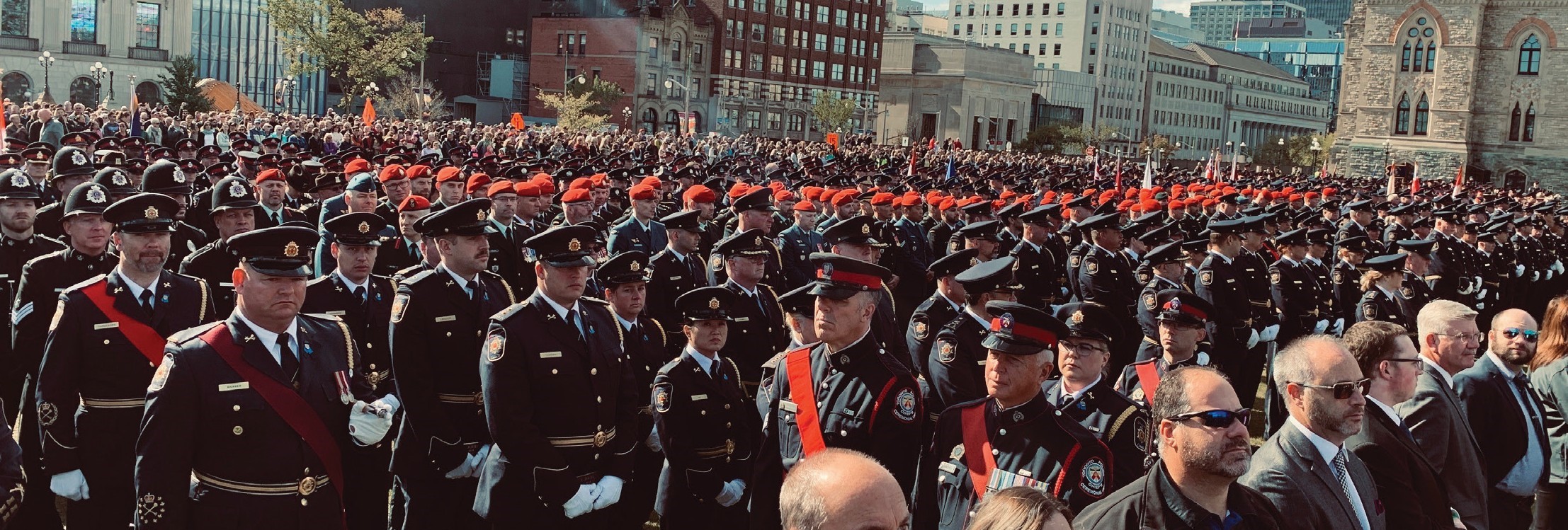
The Canadian Police and Peace Officers’ 42nd Annual Memorial Service honouring our fallen comrades took place on 29 September on Parliament Hill. As part of a network of the largest police forces in Canada. The CF Military Police was amongst police forces coming from across Canada and the US.
Photo: Lt(N) Michèle Tremblay, Public Affairs Officer, CF MP Gp.
The CF MP Gp continues to build a solid reputation of providing professional, operationally focused, independent and transparent police services at home and abroad. We contributed to domestic operations with Operation LENTUS and quickly adjusted our posture to support Operation LASER; the CAF response to the COVID-19 pandemic. Abroad, we deployed personnel in support of Operations CALUMET, IMPACT, PRESENCE, REASSURANCE, SOPRANO and UNIFIER.
I am particularly proud of the new branding and visual identity standards adopted by the MP, under the theme “Canada’s Military Police” and the launch of the CFPM Facebook page where we are able to share the stories and achievements of the men and women of the MP with the public at large.
Looking ahead to next year, we will continue to improve the MP Victim Services Program with the addition of dedicated full time civilian Victim Services positions in each of the CFNIS Regional Detachments. The Canadian Forces Protective Services Unit (CFPSU) will begin a multiyear incremental growth strategy to ensure it is resourced to meet operational demands for Close Protection (CP). We will complete a structure review of our national headquarters and will welcome the addition of a CF MP Gp Chief of Staff (COS) position at the Colonel rank. On the equipment front, we will complete the deployment of CEWs, progress the MP Pistol replacement file, and will initiate the procurement cycle for the next generation MP Operational Dress.
As I reflect on this past year, I remain extremely proud of the remarkable members of the CF MP Gp, military, civilian and contractors, who do great things for the people of Canada every day. As I look forward to mark the MP Branch 80th anniversary on 15 June 2020, I feel confident that our member’s exceptional skills, dedication and professional competence will continue to contribute to the success of CAF missions at home and abroad.

S. Trudeau
Brigadier-General
Canadian Forces Provost Marshal and
Commander Canadian Forces Military Police Group
Military Police Strategic Plan 2019-2024
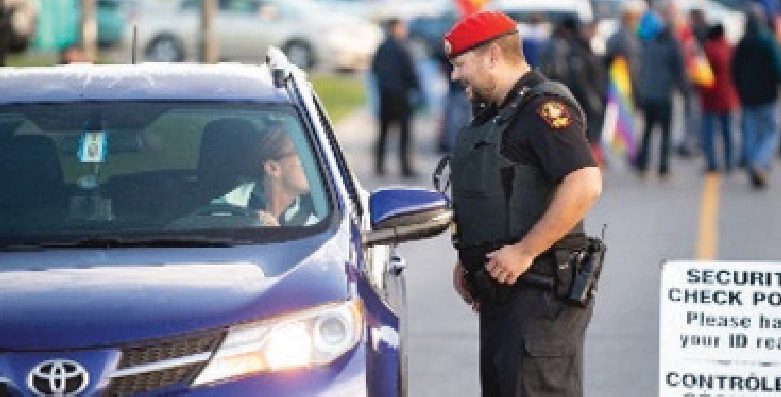
Sgt Keller with 2 MP Regiment conducts ID Check at the Royal Military College in Kingston, on October 10, 2019 to ensure all new students and staff obtained proper identification passes at the beginning of the new school year. Photo: Cpl Brandon Liddy, Imagery Technician, RMC.
At the end of fiscal year 2018-2019 the Canadian Force Provost Marshal (CFPM) put in place a five year strategic plan to be executed from 2019 to 2024. The purpose of the plan is to outline the major initiatives that will be put into place to ensure a healthy well balanced force that can execute the efficient and effective delivery of the MP program within DND/CAF.
The strategic plan has five main priorities:
- Domestic policing and Force Structure;
- Health and Wellness of the Force;
- MP Reserve optimization;
- Information Management; and
- Modernize MP Equipment and Technology.
Fiscal year 2019-2020 was the first year of the plan’s implementation and as such most of this past year’s efforts were focused on planning to meet short and long-term goals with respect to the above priorities.
Domestic Policing and Force Structure
Concentrates on ensuring that the correct level of military policing is available to meet the needs of each detachment across the country. Over the preceding years, reports were compiled to study these needs which looked at detachment level operations based on 24/7 output. The study further refined the detachments into small, medium and large base footprints.
The CFPM used this study and upgraded its recommendations in coordination with ongoing CAF Force Mix Structure Design review to determine the level of MP forces needed across the country. During 2019-2020 it was determined that the implementation of all recommendations would be far reaching with respect to the MP Branch and therefore would require an in depth Master Implementation Plan (MIP).
In order to aid with the conduct of this task a J5 Plans officer has been engaged at the CF MP Gp headquarters. The planning of the MIP has begun and will continue throughout 2020-2021. It is anticipated that the execution of the MIP will require a multi-year effort in order to take into account personnel realignment and ultimate posting movements.
During 2019 the CFPM has undertaken a review of the CF MP Gp HQ as part of the response to the Management Action Plan (MAP) proposed by ADM (RS) review of 2018. It is expected that at the conclusion of the review there will be recommendations for a more effective and efficient organization of the HQ. In order to ensure an unbiased approach to this study, Defence Research and Development Canada (DRDC) were engaged during June 2019 to conduct an initial review. The first stage of this analysis was completed for 31 March 2020 and the final report from DRDC is expected by the end of March 2021.
During this past year the Canadian Forces Protective Services Unit (CFPSU) reorganized to provide the majority of Close Protection Operators (CPOs) for existing overseas operations. As a result of this refocus the CFPSU has been allocated additional positions in order to meet the future needs of this important CAF capability. These positions will be assigned in an incremental manner over the next few years.
Overall these structural initiatives are expected to have positive impacts on the efficiency of the MP program. The implementation of each change will begin during 2020-2021 and will take several years to complete. It must be kept in mind that these changes are not static but will require constant oversight to ensure going forward that new transformations can be made as the situation dictates.
Health and Wellness of the Force
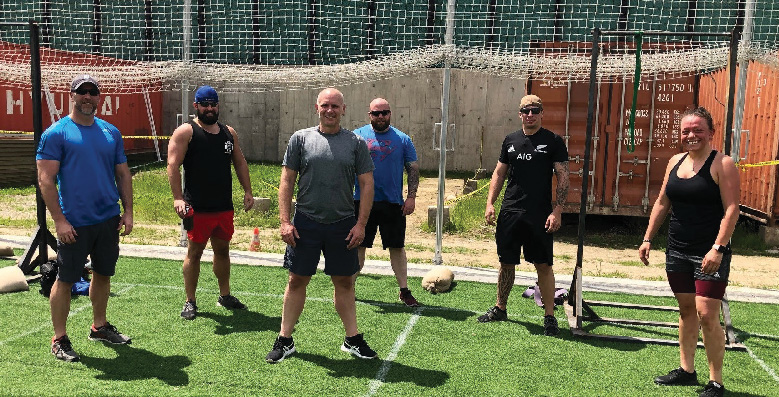
MP Security Service Detachment in Kabul, Afghanistan completes the Annual ‘’Payne Train’’ at the Canadian Embassy in presence of the Head of Mission, in honour of Cpl Payne and Cpl Dinning who lost their lives on 22 April 2006 while patrolling in Gumbad, Afghanistan.
Addresses the resilience of all MPs down to the individual level. The purpose of this program is to look at both the physical and mental health needs of the people who make up the force and their unique requirements. The Commandant of the Canadian Forces Military Police Academy (CFMPA) was assigned the task of developing a plan to meet these special demands.
The program is being put in place in concert with the ongoing CAF Balance program. In addition, this initiative is supported by the Road to Mental Readiness for Military Police (R2MR4MP). Training in this area is ongoing across Canada for all MP.
During 2019-2020 a further 157 MP personnel received this training and the program is expected to be completed during 2020-2021. As part of this ongoing priority a governance structure has been established to formalize the importance of this issue. The concerns associated with this priority will now be reviewed on an annual basis to ascertain all of the relevant ongoing obligations in this area. It is anticipated that as a result of this focus MP’s will be better prepared to meet the needs of an evolving society both physically and mentally.
MP Reserve optimization
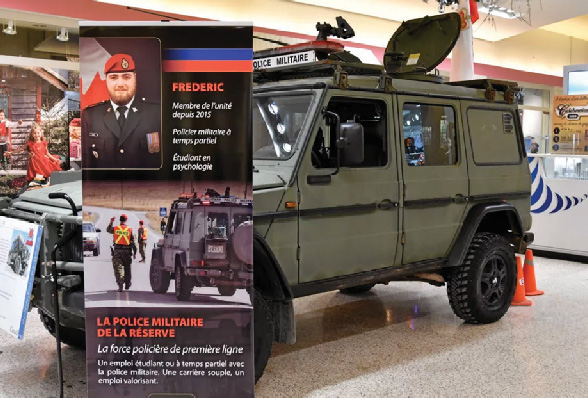
4 MP Company of 5 MP Regt participate in an employment event at Place du Royaume Shopping Center, Saguenay, Qc on 29-30 Nov 2019 to recruit MP officers and to raise awareness of the MP within the Reserve. Within one month of this event, ten potential candidate had already shown interest. Photo: Le Quotidien, November 30, 2019.
Over the past number of years it has become apparent that the special training needs of a credentialed MP force are not easily accomplished with the training time available to personnel in the MP Reserve force. That said the MP Reserve non-credentialed individual can perform most of the non policing tasks assigned to the MP. This realization has led to efforts to align an MP reserve training and employment model to better meet the reality of reserve employment. The MP Reserve is concentrated in ten Army MP Platoons across Canada with the majority of their tasks currently oriented toward the accomplishment of field tasks.
During the past year the CFPM became responsible for the Force Generation of all MP Reservists. This change will provide a more comprehensive command and control relationship to employ and administer all MP Reservists across the country. In conjunction with this change a list of MP Reservists across the country and which is administered at CF MP Gp HQ has been established to fulfill special tasks which are needed in support of MP operations.
Over the past year, COS Reserve was assigned the task of developing a Master Implementation Plan (MIP) to take into account how best to implement the training and employment of MP reservists. This MIP will allow for a phased approach to grow the MP reserve from a total strength of 403 this year to 805 within five years. Growth of the MP Reserve is expected to take place through normal recruiting and training processes across a five year period in a linear fashion.
Information Management
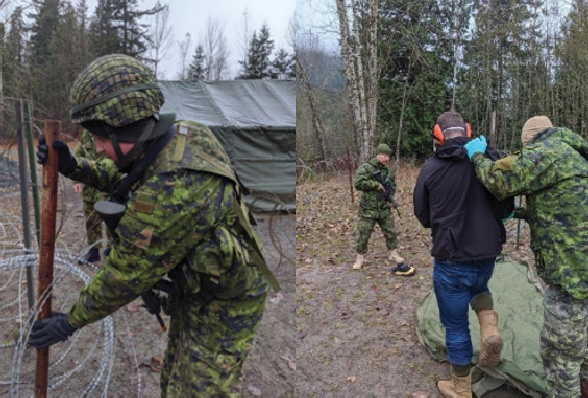
12 MP Platoon conducts Detention operations exercise during Exercise THUNDERBIRD Above at Chilliwack, B.C. on 9-10 November 2019 to maintain essential MP soldier skills and to provide deployable members for the Regiment and the local area Canadian Brigade Group. Photo: Capt Dane Nicholson, 12 MP Platoon Commander, Ex THUNDERBIRD.
Focuses on the information required to support effective decision making throughout the entire MP structure. These efforts are linked to the Departmental Review Framework (DRF) and the MP Analytics Program (MPAP). Information Management will be maintained by the analysis of data generated in the field and then fed through the application of performance metrics from MPAP. The flow of this information will permit more timely executive decision making for both short and long-term needs. Ongoing work with the DRF program during 2019-2020 has better refined and aligned the MP program to meet DND/CAF output.
The MPAP section was assigned two full time personnel in order to ensure that data quality from the field was improved and that a better interface could be achieved with the Canadian Center for Justice Statistics (CCJS).
The end state of this ongoing information improvement will be the development of improved criminal intelligence products. It is expected that the path toward this goal will take approximately five years.
Additionally MPAP is working with DRDC, as part of their mandate to provide research and development that supports DND/CAF in evidence-based decision making and management of personnel, equipment, readiness and infrastructure. Ultimately, it is anticipated that increased focus on information management will lead to a more efficient assignment of resources, personnel and equipment, at Detachment and Platoon level operations. Information Management will link into a continuous feedback loop for the first three priorities thus sustaining more robust decision making.
Modernize MP equipment and technology
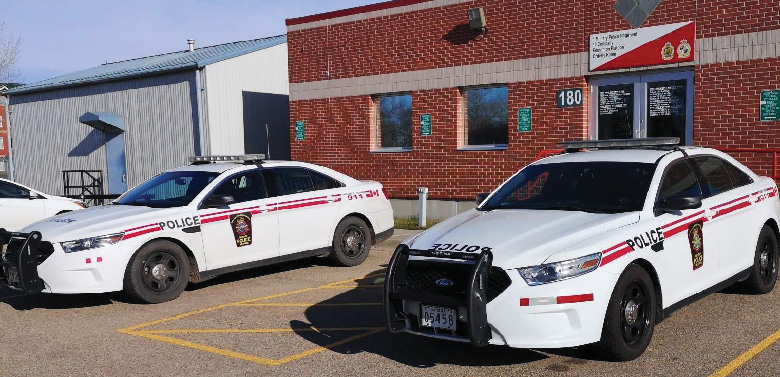
Over the past number of years the MP program has taken an incremental approach to its needs for specialized MP equipment. During 2019-2020 it was determined that a more comprehensive view of this area was required. As with other areas of the CAF it was determined that a Force Development (FD) methodology would be beneficial to ensuring a thorough review of current and future needs.
FD is dedicated to the review of equipment and structures unique to the MP program. This ensures that there is the correct amount of overlap with other FD cells across the CAF without creating unnecessary duplication. With respect to equipment requirements FD is tied into both life-cycling of in-use equipment and future technology. With respect to structures FD is linked into CAF, Chief Force Development and Chief of Program. This ensures that MP units and headquarters structures are aligned with CAF needs.
In this regard FD is reviewing the CF MP Gp HQ structure and providing input into the Domestic Policing and Force Structure MIP. During 2019-2020 the FD cell was assigned full time staff to begin the planning and coordination of all FD efforts across the Group.
MP equipment needs are divided into four (4) major areas of concern:
- Soldier Systems – all equipment worn by the MP;
- Mobility – all vehicle related equipment;
- Command, Control, Communications, Computers (C4) – information management equipment; and
- Infrastructure – all MP related permanent and temporary infrastructures used to house and support MP operations domestically.
The FD cell is currently reviewing the following equipment systems:
Soldier Systems
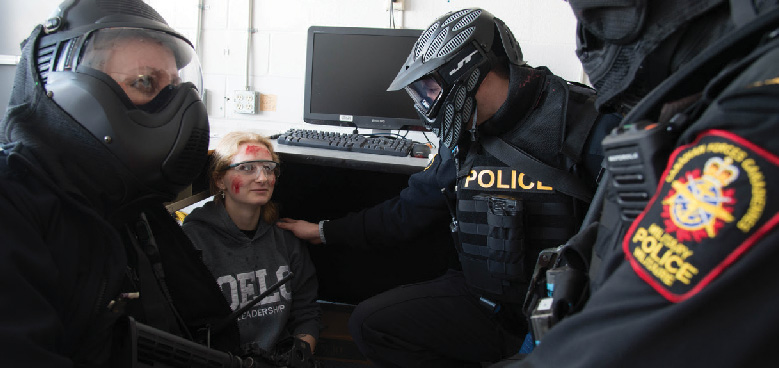
On March 3, 2020, 22 Military Police Flight conducted an emergency response exercise in cooperation with North Bay Police Service (NBPS), Ontario Provincial Police and North Bay Paramedic Services (EMS),that simulated an active shooter threat at 22 Wing. The exercise was developed to evaluate front-line emergency service response and ensure interoperability amongst law enforcement agencies. Photo: Cpl Rob Ouellette, Image Technician, 22 Wing North Bay, ON.
Enhanced Body Armour – A trial was conducted during the year to overcome the shortfalls of the current body armour system to improve officer safety and enhance functionality of the access and placement of equipment worn by the MP on their person. The new body armour cover that resulted will be contracted and deployed during 2020-2021.
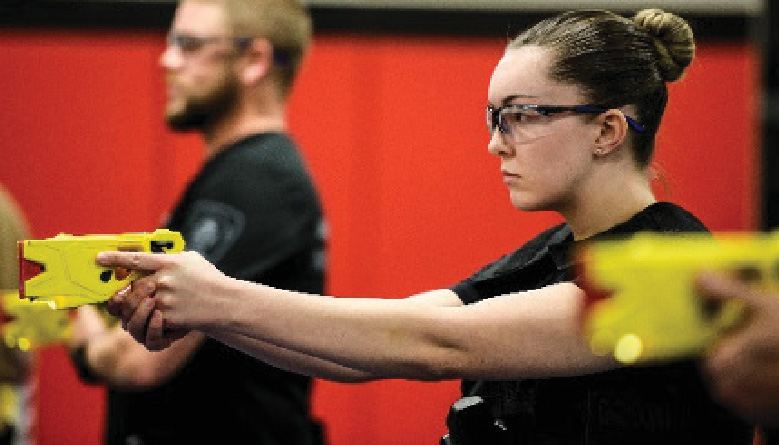
The Canadian Forces Military Police Academy runs a Conducted Energy Weapons Instructor Qualification course on December 2, 2019 at Canadian Forces Base Borden, Ontario. Photo: Cpl Caitlin Paterson.
Conducted Energy Weapons (CEW) – The CF MP Gp procured CEW during Jan 2019. In order to deploy these systems policy, training and ancillary equipment needed to be procured to ensure correct deployment to the field. Initial training commenced at the CFMPA with the rollout of instructor training and initial end-user training to QL3 and MPOC candidates. By the end of the fiscal year 26 instructors and 70 students have received training. A MIP is being developed to complete the rollout of CEW training to all MP detachments by the end of Mar 2021.
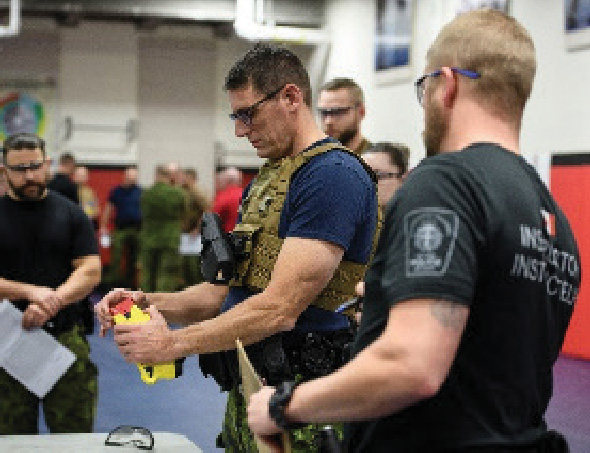
MP Pistol modernization – the current MP pistol is reaching end of life. In coordination with the Canadian Army (CA) and other environmental commands the CF MP Gp is prepared to move ahead with the replacement of it’s current in-service pistol. A Statement of Requirements (SOR) has been submitted to ADM(Mat) and once a trial of the new system is complete, which is expected during 2020-2021 it is expected that procurement of new pistols will begin during 2021-2022. The deployment of the new pistol will require a MIP to ensure that all training and implementation needs are taken into account. This MIP will be developed during 2020-2021.
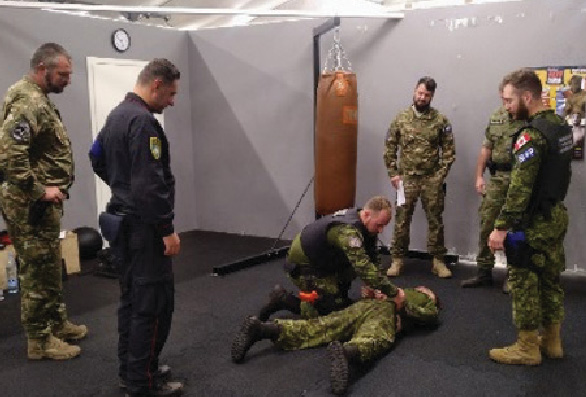
On 12 Sep 19, MP Coordination Centre (MPCC) - Op REASSURANCE Roto 12, conducted multinational Use of Force and arrest procedures training, to familiarize each nation on Use of Force tactics, in the unarmed Combat room, Camp Adazi, Latvia. Each Sending Nation (SN) provided a lesson on their Use of Force tactics and arrest procedures and all tested their skills with some hands on training. Photo: CAN Leading Seaman Fran, Op REASSURANCE.
Next Generation MP Operational Dress (NGMPOD) – this project has begun during 2019-2020 with the stand-up of a working group to review end-user inputs. The NGMPOD will focus on interoperability, function, safety and the latest garment technology. A SOR will be completed during 2020-2021 and delivered to ADM(Mat) for eventual procurement through normal channels. It is expected that deployment of the NGMPOD will be completed in 2023.
Mobility

The seven last vehicles of 18 to be distributed to units this year.
Mobility is focused on the life-cycling of all MP vehicular assets at this time. This includes all related vehicle bourne equipment such as police lights, radars, mobile vehicle recording systems, and computer related equipment. FD works closely with the CF MP Gp HQ J4 in the accomplishment of this task. The FD cell will review the capability for Hybrid related police vehicles during 2020-2021.
Command, Control, Communications, Computers (C4)
Information management equipment. In coordination with the CF MP Gp HQ J6, FD is reviewing all computer life cycle requirements for the Group. In addition, the J6 has developed a five year equipment plan that addresses both hardware and software needs for the Group. FD and J6 will work with ADM(IM) to determine the best method of fulfilling these needs which focus on, tactical communications at the detachment and platoon level (voice and data), secure data communications for police related issues from the detachment to all levels of HQ, the upgrading and development of the Security and Military Police Information System (SAMPIS) network.
Infrastructure
An initial review of all MP infrastructure across Canada has taken place. Although the CF MP Gp HQ does not currently have dedicated engineer resources assigned to it, ADM(IE) has agreed to support specific needs and projects. The CFPM has directed that a common MP Guardhouse be developed in order to standardize this portion of MP specific infrastructure. ADM(IE) has agreed to assign a project engineer to this issue and initial drawings are anticipated during 2020-2021.
Military Police Legal Services
Two major developments in the legal domain in 2019 have far reaching implications for the CF MP Gp and the CAF and both strengthen, legitimize and inspire confidence in the Military Justice System (MJS).
Royal Ascent to Bill C-77
Bill C-77 received Royal Ascent on 21 June 2019. This Bill brought significant changes to the MJS, notably by creating a Declaration of Victims’ Rights (DVR) which closely mirrors the Canadian Victims Bill of Rights. It also contains a series of “service infractions” that will be heard by “summary hearings” rather than “service offences” heard by “summary trials”. Once those amendments come into force, service offences will only be heard by court martial.
Consistent with Parliament priorities and Canadian values, the CF MP Gp remain committed to support victims throughout the investigative and judicial processes with robust policies and practices and professional independent police investigations. For example, the MP proactively instituted its own Victims Service policy which addresses many protections found in Bill C-77 DVR to the extent it can based on extant authority.
Supreme Court Decision R v. Stillman
The second development came from the Supreme Court of Canada in the decision R v. Stillman, rendered on 26 July 2019. The court concluded that both the military exception to the right to be tried by a jury and the distinct military trial system are constitutional.
Consequently, a person accused of offences promulgated by an Act of Parliament other than the National Defence Act (NDA) under the Code of Service Discipline (CSD) can be tried by a court martial while facing the full array of sentences associated with these offences. In other words, this decision re-affirms the military nature of civilian offences committed by persons who are subject to the CSD and tried within the MJS.
Improvements to MP Professional Standards
The CF MP Gp’s legal team reviewed the administrative law principles governing the decision-making processes of the Office of Professional Standards (PS) and the MP Credential Review Board (MPCRB). This review aimed at assisting the PS and the MPCRB in rendering decisions that result from and reflect the appropriate legal tests, adhere to the applicable legal principles, are informed by the most recent jurisprudence and benefit from the latest best practice in the administrative law domain.
Consequently, initial decisions and reviews will adhere more systematically to procedural fairness principles. Written decisions will reflect the proper legal tests more clearly and their motives will be better substantiated. This should enhance the credibility and the legitimacy of those decision-making bodies in the eyes of the affected persons and the broader public.
Specialized legal training was provided to all members of the MPCRB to increase the Board’s efficiency and the quality of its decisions. Concurrently, the CF MP Gp began an in-depth overhaul of the orders governing PS activities.
Forthcoming orders will update professional responsibilities for the entire MP chain of command, clarify PS review processes under NDA Part IV and provide a framework to improve compliance with the latest legal standards across the MP Gp. The orders will also introduce a new system for the effective and efficient informal resolution of public complaints for MP misconduct, whenever possible.
Response to the Auditor General Report on Administration of Military Justice
The 2018 Report of the Auditor General of Canada relating to the administration of Military Justice noted that “The CAF should establish formal communication processes to ensure that the MP, the DMP, the JAG’s legal officers, and the military units receive the information that they need to carry out their duties and functions in a timely manner.”
One of the measures adopted to address this was the creation of a new full-time position for a legal advisor to provide direct support to the CFMPA. This is an important milestone in providing legal support to the CF MP Gp. The legal officer assigned to the CFMPA has already commenced the review of existing courseware in conjunction with a colleague from the Military Prosecutions Service.
Similarly, all new course material will benefit from an internal military lawyer to increase the quality of the course material, the accuracy of its legal content, and the professionalization of every MP and MPO graduating from a CFMPA course or program.
Highlights
Numerous exercises promoting interoperability among local emergency services
In recent years, real-world events in schools, military establishments, and other public areas throughout North America are impressing upon us the need to remain ready to intervene. Consequently, MP on bases and wings constantly train and verify lockdown and hold-and-secure procedures through emergency response exercises that simulate threats and emergency situations emerging from those threats. Exercises within bases and wings are developed to evaluate frontline emergency service response and ensure interoperability with law enforcement agencies and first responders.
Exercise WING DRAGON, held in North Bay in March 2019 is one of many held across bases and wings.
“Working with all policing organizations ensures efficient response when dealing with any emergency and volatile situation” - Staff Sergeant William McMullen, North Bay OPP Detachment Commander.
“Emergency response exercises strengthen the working relationships between the agencies involved. Understanding the roles of all involved in a multi-agency emergency response allows for a real life event to be responded to at the highest level of capability.” - Dan Raymond, Manager of Paramedic Services North Bay Regional Health Centre.
Innovative training delivery
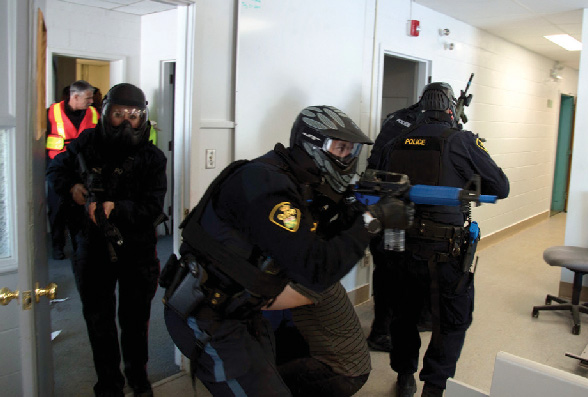
On Tuesday, March 3, 2020, members of the North Bay Police Service (NBPS); Ontario Provincial Police (OPP), Emergency Medical Services (EMS), and 22 MP Flight took part in an active shooter/aggressor exercise to further develop their collaborative response to an active threat scenario. Photo: Cpl Rob Ouellette, Image Technician, 22 Wing North Bay, ON.
The 2019 calendar year saw significant innovation to training delivery at the CFMPA. The Academy welcomed a Legal Advisor from the office of the Judge Advocate General (JAG) who has proven invaluable toward reviewing and updating training materials and keeping pace with case law and legal best practices. CFMPA also led integration of the CEW capability into domestic law enforcement operations through Initial Cadre Training, and development of courseware related to Use of Force instruction at the Academy and within the frontline detachments.
In 2019, CFMPA conducted the pilot serial of the enhanced MP Investigators Course (MPIC). Nearly doubling the training days to 24. The improved MPIC includes several new Performance Objectives relating to major case management and preparation for court proceedings.
To assist with instruction and review of new course materials, CFMPA enjoyed the support of a representative from the Director of Military Prosecutions (DMP). While improvements will continue to be made with the next MPIC serial in 2020, MP employed with the CFNIS will now be better prepared to contribute to the Military Justice System (MJS).
The transformation of MP Qualification Level 6A into an online course to be delivered through the Distance Learning Network was completed. This year’s pilot course tested on CFMPA staff was a success, and when implemented in 2020, should reduce the backlog of MP personnel awaiting training while virtually eliminating the costs associated with transporting and housing students at Canadian Forces Base Borden.
CFMPA improved lines of communication with civilian law enforcement Training Establishments. As a result the Academy Close Protection subject matter experts contributed to the Ontario Police College (OPC) Close Protection training plan and curriculum development. CFMPA also hosted OPC’s Close Protection project team on several occasions to observe the conduct of the Close Protection Operator Course Serial 1902, sharing best practices and Lessons Learned.
As the CFMPA continues to review and update its training practices the MP program continues to produce superior MP professionals into the future.
MP on Social Media
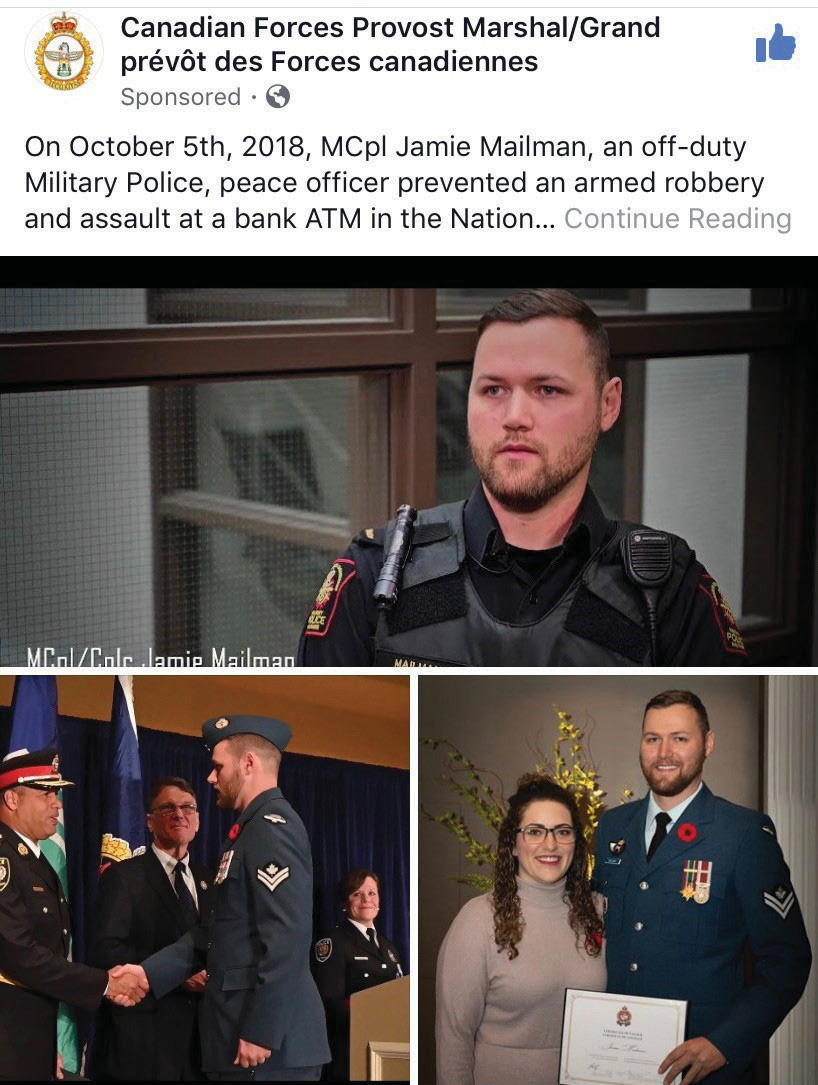
On 12 November 2019, the CFPM launched a bilingual official Facebook (FB) page as a more direct and efficient method for communicating with the public. The CFPM FB page is distinct from the CAF page although both are meant to be complementary. The new FB page has enabled the CFPM to better connect with Canadians about Canada’s MP all while supporting the wider strategic communications priorities of the DND and CAF.
In its first three months, the FB page reached over 146,000 people, obtained more than 1000 likes and received overall positive feedback. Of note, the video post featuring the state of the art MP Academy has achieved over 20,000 views since posted in early December.
The FB page has provided a platform to readily share the stories and achievements of the MP both at home in Canada and abroad. This platform has also provided an opportunity to showcase MP working with the defence community and collaborating with our civilian police partners to ensure high readiness in today’s environment.
The launch of the CFPM FB page has moved the MP into the virtual social media space in order to permit a closer link with those we serve. We look forward to using this method of communication to foster a more transparent and open relationship with the public at large.
Sexual Assault Review Program (SARP)
The CFPM launched the SARP in November 2018. SARP saw the implementation of an open and transparent case review mechanism of unfounded sexual assault files investigated by the MP using an External Review Team (ERT) comprised of members from the civilian and DND/CAF community.
The ERT assembled, in December 2018 and in May 2019, to review all unfounded sexual assault files from 2010 to 2018.
In the second phase of the review, a member with Children Protection Aid Society and a member representing the national Junior Cadet Rangers also participated. The second phase completed the review of the initial 113 files from 2010 to 2016, and added the ones of 2017 and 2018.
Over the course of the file review, the ERT commented that MP investigators developed very good rapport with the victim, validating the continued need for trauma informed sexual assault investigation training, which was proactively adopted by the CFNIS in 2016.
The ERT reviewed 126 files. Their findings reaffirmed that for the most part files were properly coded as unfounded at the time of conclusion. However due to recent changes in clearance coding from the CCJS, the clearance status of some files were amended to reflect coding that applies today.
- 54 files remained coded as “Unfounded”
- 2 files were coded “Founded, Not Cleared”
- 1 file was coded “CSC less than 12 years old”
- 7 files where coded “Complainant requested no further action (CSC identified)”
- 9 files where coded “Departmental discretionFootnote 1”
- 5 files coded as “UnsolvedFootnote 2”
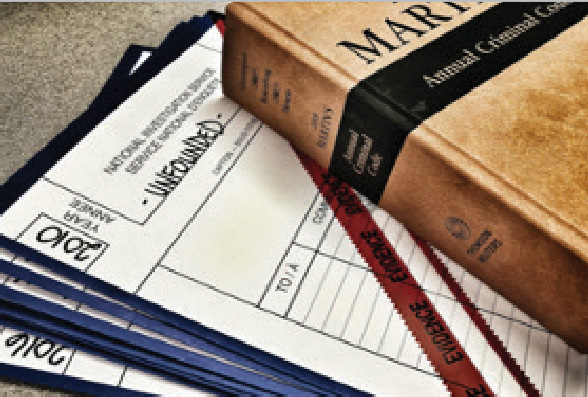
The SARP is now a proven program available as an additional tool of accountability to the Defence Community members and transparency to the Canadian public. An ERT can now be assembled within legal framework respecting privacy of the people expressed in files, while involving representatives of the public. The ERT was able to efficiently review all type of cases on sexual offences including cases involving young people.
Colonel Vanessa Hanrahan deployed to UNMISS as Force Provost Marshal. One of Canada’s top female MP Officers is the Provost Marshal of the UN Mission South Sudan (UNMISS).
Task Force South Sudan is comprised of 17% female personnel of which Colonel Vanessa Hanrahan is the most senior.
Created in 2011, UNMISS has approximately 15,000 military personnel and 2,800 civilians. Col Hanrahan deployed in November 2019 to assume the role of Provost Marshal of TF - South Sudan, advising the TF Commander on all aspects of military policing in South Sudan.
Three months into the deployment, Col Hanrahan, charged with responsibility of the Force MP explained that it had been a rewarding challenge. She stated it was an excellent experience in terms of working at the operational level with military police officers of several nations who bring a valued diversity of MP experience and cultural perspective.
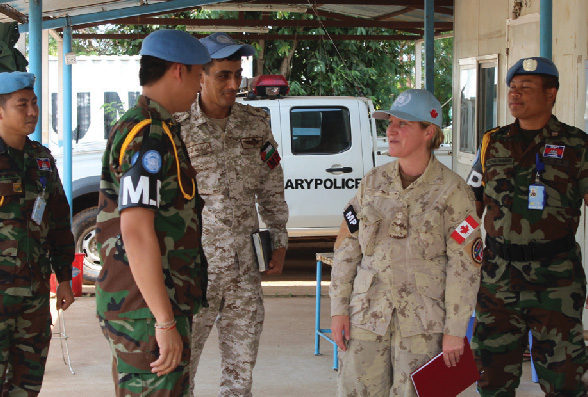
“Though we bring a variety of methods to address the challenges we face, at the end of the day we are all the same - members of our respective militaries working together to provide safety and security to South Sudanese,” describes Col Hanrahan.
As one of Canada’s senior MP officers, she has served in a variety of positions such as the Canadian Army Provost Marshal and Special Advisor to the CFPM. Col Hanrahan brings a wealth of military policing and leadership experience to UNMISS.
“She was selected amongst top candidates from five nations - and that is a success… She is the first female Provost Marshal on this UN mission - and that is pretty cool too! ”, stated BGen Simon Trudeau, CFPM and Commander of the CF MP Gp.
MP recognized by Ottawa Police Chief
On October 5th, 2018, MCpl Jamie Mailman, an off-duty MP member, prevented an armed robbery and assault at a bank ATM in the National Capital Region. In recognition of this act of bravery on November 6, he was awarded the Certificate of Valour by the Chief of Police of Ottawa, Peter Sloly and Mr. Sandy Smallwood, Ottawa Police Chair.
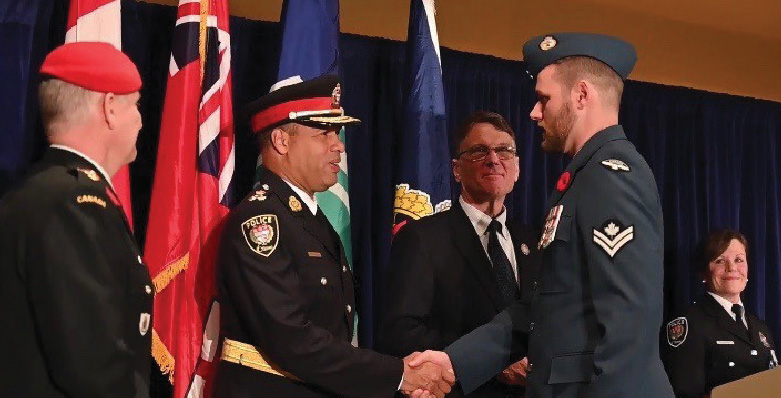
MCpl Jamie Mailman receives Certificate of Valor from Ottawa Police chief Peter Sloly on Nov 6, 2019 in presence of Mr. L.A. (Sandy) Smallwood, Ottawa Police Board Chair and Col Martin Laflamme, Deputy Commanding Officer of the CF MP Gp.
Message from the Canadian Forces Military Police Group Chief Warrant Officer
The CF MP Gp CWO change of appointment took place in July 2019. This concluded an engaging three years for CWO Éric Saint-Pierre. I would like to take this occasion to sincerely thank CWO Saint-Pierre for his mentorship and guidance to the NCM Corps as well as for his commitment to the whole Formation and MP Branch.
As you have noted in this report, 2019 saw a steady progression towards the accomplishment of the strategic goals of the MP. Many initiatives have now progressed towards fruition while some others are just now being initiated.
As our entire team of regular force, primary reserve, public service and contractors, represent our most valued and important resource, we remain committed to developing programs that strengthen and enhance the resilience of our force. As such the R2MR4MP has been and will continue to be provided at CFMPA and delivered to all units.
The focus on extending resilience to the force will be further enabled thru a continuum of supporting programs. The CFMPA has initiated the development of an MP annex to BALANCE, the CAF physical performance strategy. This annex will convey the CFPM/Comd CF MP Gp’s vision of achieving the aim of BALANCE while proposing strategies tailored to the reality, diversity and range of MP employment that is characterized by an atypical work schedule and/or remote work locations.
During our visits, gatherings and town halls, the dynamism, engagement, and desire to provide first-class service to the public was always palpable and evident from our team members. This was echoed in bilateral discussions with allied Senior MP NCMs at this year’s NATO MP Chief’s conference where Canadian MPO and MPs were held in high regard for their agility to respond to different tasks, competence, professionalism and leadership while serving abroad or in international exercises.
I would be remiss if I did not take the time to highlight five extraordinary achievements by members of the Branch: the introduction of LCol V.M. Hanrahan and CWO J.C.E.J. Lacoste to the Order of Military Merit, CWO D.M.A. Ridley as recipient of the Liz Hoffman Memorial Commendation, MCpl J.R. Mailman as recipient of the City of Ottawa Certificate of Valour, as well as the remarkable feat achieved by Cpl M.G. Cardinal who sets a new International Powerlifting Federation world record of 372.5 kg (821 lb) in the deadlift at the North American Powerlifting Federation Championship in San Jose, Costa Rica, August 2019.
In closing, I’m truly honoured and humbled to be the present CF MP Gp CWO. I’m continually amazed by the acts of dedication, empathy, professionalism, and utter commitment demonstrated by all of our team members whether at home or abroad. They unquestionably form the most versatile, highly skilled and finest police force in our country – Disciplinare per exemplum!
Annex A: Analytics - Sexual Offences
Operation HONOURFootnote 3 is the Canadian Armed Forces (CAF) mission to eliminate harmful and inappropriate sexual behaviour in the Canadian military. The Directorate Professional Military Conduct Operation Honour (DPMC-OpH) leads the CAF response at the strategic level to eliminate such behaviour from the Canadian Military. The Sexual Misconduct Response Centre (SMRC) was created in 2015 as a dedicated independent support centre, providing support for CAF members affected by sexual misconduct and works in conjunction with the military to increase understanding, improve preventative measures and enhance the response to these behaviours within the department.Footnote 4 In July 2017, the SMRC expanded its services to provide 24/7 confidential counselling and support.
Information reflected in this Annex provides an overview of sexual-related incidents reported over the past four years with the goal of providing insight into the severity and rate at which sexual-related incidents are reported, as well as other possible issues related to sexual misconduct within the CAF.
The Security and Military Police Information System (SAMPIS), the primary Records Management System (RMS) for the Canadian Armed Forces Military Police (CF MP), was utilized to fulfil the request within the scope and capacity of the database.
Analysis
Between 1 January 2016 and 31 December 2019, Military Police (MP) were made aware of and documented a total of 1,376 sexual-related incidents in SAMPIS; of which 1,316, or 95.6% were determined to be founded. On average, there are 329 such incidents brought to the attention of MP annually (between 281 and 377 reports).Footnote 5 Statistics Canada noted an increase in the rate of sexual assaults reported since 2015. It is speculated that public discussion surrounding issues of sexual misconduct spawned from the rise of the #MeToo movement in 2017 may have had an impact on the willingness of victims to report sexual assault incidents to police resulting in the higher reporting rates.Footnote 6 Similarly, MP have observed an overall increase of 3.4% in the number of sexual-related incidents reported from 2016 to 2019. However, there was a decrease of 6.7% in reporting in 2019 when compared to 2018. Due to fluctuations in reporting observed between 2016 and 2019, it is difficult to determine whether the downward trend of 2019 will continue into the future or not.
Caution should be used when predictions are based on a short period of review as fluctuations in reporting can have a larger impact and estimates will be less reliable. Determination of crime levels are more accurate when based on a minimum of five years (or more) of data. Statistics also do not take into account any programs and initiatives which may affect reporting nor do they provide us with insight as to possible causes for an increase or decrease in reporting. While it can be difficult to predict how many incidents involving sexual offences MP can expect in the coming years, based on current numbers it is predicted that there will be between 300 and 403Footnote 7 such incidents by the end of 2020; an estimated increase of 5.2% in reporting in comparison to 2019 when we look at the predicted average.
Of the 1,316 founded sexual-related incidents reported since 2016, 547 have been cleared; resulting in a clearance rate of 41.6%. Of these cleared files, 276 have been cleared by the laying or recommended laying of charges and 271 by some other means including it being cleared by another agency and the use of departmental discretion. Of the remaining 769 incidents that have not been cleared, 559 have been concluded and are not currently under active investigation. Approximately a third of these (196 incident) were concluded as there was insufficient evidence to proceed or because the victim/complainant declined to proceed. With regards to incidents determined to be unfounded, 2.8% of sexual assault incidents reported to or brought to MP attention were determined to be unfounded.Footnote 8 This is well below the national average reported by Statistics Canada who reported that 11% of sexual assaults were classified as unfounded in 2018, 14% in 2017, and 19% in 2016. The decline in incidents considered unfounded is likely related to a 2017 amendment to the definition of “founded” criminal incidents in the Uniform Crime Reporting (UCR). Additionally, in January 2018, new options became available as to why an incident was “not cleared” or not solved. These changes have also likely had an impact on clearance rates.Footnote 9
Figure 1: Sexual-related incidents reported between 1 January 2016 and 31 December 2019 with 2020 prediction. * see Data Table 1 for additional information
| Type of Sexual-related Offence (Primary or Most Serious Sexual Offence) |
Report Year & 2020 Prediction | ||||
|---|---|---|---|---|---|
| 2016 | 2017 | 2018 | 2019 | 2020 Prediction (average) |
|
| Sexual Assaults | 238 | 223 | 280 | 251 | 272 |
| Sexual Offences against Children | 39 | 35 | 30 | 38 | 34 |
| Other Sexual Violations | 46 | 43 | 48 | 45 | 46 |
| Total | 323 | 301 | 358 | 334 | 352 |
Figure 2: Clearance Status of sexual-related investigations between 2016 and 2019 and those that have been Concluded. * see Data Table 2 for additional information
| CCJS Status (Clearance Status) | Operational Status Internal Investigative Status) | ||
|---|---|---|---|
| Ongoing | Concluded | Total | |
| Unfounded | 3 | 57 | 60 |
| Not Cleared | 210 | 559 | 769 |
| (X) Unsolved | 38 | 10 | 48 |
| (Y) Insufficient Evidence | 9 | 117 | 126 |
| (Z) Victim Declines to Proceed | 4 | 79 | 83 |
| (B) Not Cleared | 159 | 353 | 512 |
| Cleared - by Charge/Charge Recommended | 21 | 255 | 276 |
| (C) Cleared by Charge | 20 | 223 | 243 |
| (W) Charges Recommended but Declined by Crown | 1 | 32 | 33 |
| Cleared - Otherwise | 5 | 266 | 271 |
| (D) Suicide of CSC | 0 | 1 | 1 |
| (E) Death of CSC (not suicide) | 0 | 6 | 6 |
| (F) Death of Complainant / Witness | 0 | 0 | 0 |
| (G) Reason Beyond Control of Department (policy) | 0 | 10 | 10 |
| (H) Diplomatic Immunity | 0 | 0 | 0 |
| (I) CSC Under 12 Years of Age | 0 | 1 | 1 |
| (J) Committal of CSC to Mental Health Facility | 0 | 0 | 0 |
| (K) CSC Outside Canada (cannot be returned) | 0 | 0 | 0 |
| (L) Victim / Complainant Requests that No Further Action is Taken (CSC identified) | 1 | 31 | 32 |
| (M) CSC Involved in Other Incident(s) | 0 | 1 | 1 |
| (N) CSC Already in Jail | 1 | 10 | 11 |
| (O) Departmental Discretion | 2 | 75 | 77 |
| (R) Diversionary Program | 0 | 13 | 13 |
| (S) Incident Cleared by a Lesser Statute | 0 | 0 | 0 |
| (P) (T) Incident Cleared by Other Agency (Federal, Provincial, municipal) | 1 | 118 | 119 |
| Total | 239 | 1,137 | 1,376 |
Figure 3: Sexual-related incidents that occurred within Environments and regional AORs 2016-2019. * see Data Table 3 for additional information
| Regional AOR in which Incidents Occurred | Environment in Command of Region | |||||
|---|---|---|---|---|---|---|
| RCAF | RCN | CA | Support / Training | Other / Unknown | Total | |
| Pacific | 28 | 69 | 35 | 0 | 15 | 147 |
| Western | 58 | 0 | 134 | 1 | 19 | 212 |
| Borden | 0 | 0 | 50 | 113 | 23 | 186 |
| Central | 49 | 0 | 163 | 64 | 24 | 300 |
| Eastern | 15 | 0 | 154 | 2 | 10 | 181 |
| Atlantic | 52 | 74 | 91 | 2 | 14 | 233 |
| Other / Unknown | 1 | 4 | 0 | 14 | 38 | 57 |
| Total | 203 | 147 | 627 | 196 | 143 | 1,316 |
Sexual related incidents occurred more frequently within areas under or surrounding Canadian Army (CA) establishments; accounting for 47.6% of all such reporting between 2016 and 2019. This is above that reported by other environments: Royal Canadian Air Force (RCAF) 15.4%, Royal Canadian Navy (RCN) 11.2%; Training/Support bases 14.9%; and other or unknown 10.9%.Footnote 10 This trend was seen regularly, with nearly half of all such incidents reported to have occurred within or near CA establishments annually since 2016. It is important to keep in mind that this may be due to the fact that the CA is the largest of the three environments,Footnote 11 with bases and units across Canada. It should also be noted that while sexual-related incidents may have occurred within defence establishments, this does not mean that CAF/DND personnel were involved.
Almost a quarter (22.8%) of sexual-related incidents were reported to have occurred within the Central regionFootnote 12 since 2016. However, a closer look at specific municipalities/districts where incidents occurred indicates that Borden (9.1%), followed by Gagetown (7.7%), Montreal (7.1%), and Kingston (6.9%) had higher rates of sexual-related incidents than any other area. While it is not known why rates are higher in these places, it can be noted that each hosts a training facility and/or school.Footnote 13 Further and more in-depth analysis would be required to determine if there is a correlations between higher rates of reporting being associated to schools and training facilities.
42.3% of the sexual-related incidents brought to MP attention since 2016 were reported within a week of the incident occurring; 53.4% within a month. An additional 19.2% were reported a month to a year after occurrence. Over a quarter (27.4%) of sexual-related incidents reported to MP between 2016 and 2019, can be considered historic, meaning they were reported a year or more after the incident occurred. By nature of the offence and emotional trauma endured, sexual assaults, relative to other types of violent crimes, may not immediately be reported to police.Footnote 14
Figure 4: Time elapsed (days) between incident occurrence and date reported to police. (* see Data Table 4 for additional information)
| Type of Sexual-Related Offence | Incident Report Time | |||||
|---|---|---|---|---|---|---|
| - | 0 days | 1-7 days | <= 1 month | 1 month – 1 year | 1-10 years | >10 years |
| Sexual Assaults | 148 | 240 | 116 | 189 | 184 | 115 |
| Sexual Offences against Children | 34 | 30 | 11 | 31 | 17 | 19 |
| Other Sexual Violations | 61 | 44 | 19 | 32 | 19 | 7 |
| Total | 243 | 314 | 146 | 252 | 220 | 141 |
As noted moderate increase in the overall number of sexual-related incidents reported between 2016 and 2019. However, to determine if MP, like their civilian counterparts, experienced a higher rate of reporting of historic sexual-related complaints following the implementation of Operation Honour or the #MeToo movement and whether these initiative were the reason victims felt encouraged to report such events, further analysis into historic sexual-related occurrences would be required.
With so many sexual-related incidents being reported after the passage of some time, it would be difficult to accurately determine specific days and times when offences generally occurred. However, based on the information reviewed, slightly more sexual-related incidents were reported to have occurred on a Friday or Saturday; however, the number of reported incidents was fairly evenly spread throughout the week. When time of day incidents were reported to have occurred was reviewed, it was found that more were reported to have occurred between midnight and 4:00 am than any other block of time.
Examining the information provided we can see that 38.8% of sexual-related incidents were reported over the course of the weekend; meaning between 8pm on Friday evening and 4am Monday mornings. However, the majority (61.3%) of incidents were reported to have occurred during the regular work week; with a third of these reportedly occurring during business hours (between 8am and 4pm Monday to Friday). Further analysis would be required in order to determine if this indicates that sexual offences were occurring in the workplace or if there is an issue with the quality of the data entered.
A review of flags and special study fields associated with Table 1, 1,316 sexual-related incidents (founded) reported to MP between 2016 and 2019, provides some insight into how these incidents came to MP attention, and some factors involved. 66 reports were transferred to CF MP Gp from the MP LO position currently embedded within the SMRC as having been received via the CAF Strategic Response Team (CT (which will be changed in the future to SMRC)) 20 were flagged as occurred at the Royal Military College, but significantly more (257) incidents involved Cadet camps or units. Alcohol and/or drug consumption was recorded as having been a factor in 29.2% of incidents and family violence in 7.3% of occurrences. As this type of information is dependent on data entry by MP, it is possible that flags may be underutilized; specific factors involved in sexual-related incidents, such as alcohol consumption, may therefore appear to be lower than are in reality.
| Time of Occurrence (time of day incidents reported to have occurred) | Day of Occurrence (day of week incident reported to have occurred) | - | ||||||
|---|---|---|---|---|---|---|---|---|
| Monday | Tuesday | Wednesday | Thursday | Friday | Saturday | Sunday | - | |
| 00:00 – 3:59 hrs | 78 | 54 | 59 | 51 | 82 | 89 | 60 | 473 |
| 4:00 am. – 7:59 | 9 | 8 | 12 | 3 | 11 | 9 | 13 | 65 |
| 8:00 am – 11:59 | 37 | 29 | 29 | 27 | 18 | 23 | 26 | 189 |
| 12:00 – 15:59 | 28 | 26 | 27 | 21 | 24 | 18 | 23 | 167 |
| 16:00 – 19:59 | 34 | 25 | 24 | 30 | 41 | 32 | 16 | 202 |
| 20:00 – 23:59 | 11 | 20 | 29 | 37 | 50 | 54 | 19 | 220 |
| - | 197 | 162 | 180 | 169 | 226 | 225 | 157 | 1,316 |
Figure 5: Factors involved in sexual-related incidents and other Special Study Flags. (* see Data Table 5 for additional information)
| Special Study Fields and Flags (of founded sexual-related Incidents) | Report Year | ||||
|---|---|---|---|---|---|
| - | 2016 | 2017 | 2018 | 2019 | Total |
| (CT) Rec’d via CSRT-SM | 26 | 13 | 18 | 9 | 66 |
| (CR) Cadet Camp / Unit Related | 0 | 1 | 9 | 10 | 257 |
| (RM) Royal Military College | 58 | 49 | 81 | 69 | 20 |
| (VA) Victims Assistance | 77 | 92 | 123 | 111 | 403 |
| Alcohol/Drug Consumption | 98 | 93 | 100 | 93 | 384 |
| Family Violence | 30 | 22 | 19 | 25 | 96 |
Without a review of each individual incident/record involved, answers to specific questions are not possible due to limitations in the records management system used and the corresponding unavailability of relevant statistical information. A review of the methodology and resulting data is helpful in understanding how the statistics were derived, highlighting the limitations placed on analysis.
Other published reports, such as “Sexual Misconduct in the CAF, 2018” produced based on results from the Survey on Sexual Misconduct in the CAF conducted by Statistics Canada in 2018 can provide some insight into the circumstances and correlations involved in sexual-related incidents reported as it was a voluntary survey completed by CAF members about their experiences and perceptions of inappropriate and discriminatory sexualized behaviour within the CAF.Footnote 15
Data tables
Data Table 1: Sexual-related incidents reported between 1 January 2016 and 31 December 2019 with 2020 Prediction.
| Type of Sexual Offence | Total Reported | Total Founded | 2016 | 2017 | 2018 | 2019 | Percentage of Change | Annual Ave. | 2020 Prediction (range)Footnote 16 | ||
|---|---|---|---|---|---|---|---|---|---|---|---|
| 2016-2019 | 2018-2019 | ||||||||||
| Sexual Assaults | Level 3 –Aggravated | 5 | 5 | 1 | 0 | 3 | 1 | 0.0 | -66.7 | 1.3 | 0-5 |
| Level 2 – Weapon/ Bodily Harm | 3 | 3 | 1 | 0 | 1 | 1 | 0.0 | 0.0 | 0.8 | 0-3 | |
| Level 2 – Weapon (OUTCAN) | 0 | 0 | 0 | 0 | 0 | 0 | 0.0 | 0.0 | 0.0 | 0 | |
| Level 1 | 1,013 | 984 | 236 | 222 | 276 | 249 | 5.5 | -9.8 | 246 | 221-317 | |
| Total | 1,021 | 992 | 238 | 222 | 280 | 251 | 5.5 | -10.4 | 248 | 221-323 | |
| Sexual Offences Against Children | Sexual Offences – Other | 59 | 53 | 9 | 16 | 7 | 21 | 133.3 | 200Footnote 17 | 13.3 | 6-34 |
| Sexual Interference | 34 | 31 | 9 | 5 | 11 | 6 | -33.3 | -45.5 | 7.8 | 0-14 | |
| Invitation to Sexual Touching | 14 | 13 | 7 | 2 | 3 | 1 | -85.7 | -66.7 | 3.3 | 0-3 | |
| Sexual Exploitation | 25 | 20 | 7 | 3 | 4 | 6 | -14.3 | 50.0 | 5.0 | 0-9 | |
| Incest | 4 | 4 | 0 | 3 | 0 | 1 | n/cFootnote 18 | n/c | 1.0 | 0-5 | |
| Corrupting Morals | 0 | 0 | 0 | 0 | 0 | 0 | 0.0 | 0.0 | 0.0 | 0 | |
| Luring a Child | 23 | 21 | 7 | 6 | 5 | 3 | -57.1 | -40.0 | 5.3 | 1-3 | |
| Total | 159 | 142 | 39 | 35 | 30 | 38 | -2.6 | 26.7 | 35.5 | 23-44 | |
| Other Sexual- Related Offences | Anal Intercourse | 0 | 0 | 0 | 0 | 0 | 0 | 0.0 | 0.0 | 0.0 | 0 |
| Bestiality | 0 | 0 | 0 | 0 | 0 | 0 | 0.0 | 0.0 | 0.0 | 0 | |
| Voyeurism | 41 | 41 | 9 | 9 | 9 | 14 | 55.6 | 55.6 | 10.3 | 10-18 | |
| Distribution of Images | 13 | 10 | 3 | 2 | 4 | 1 | -66.7 | -75.0 | 2.5 | 0-5 | |
| Indecent Acts | 67 | 62 | 16 | 16 | 13 | 17 | 6.3 | 30.8 | 15.5 | 11-20 | |
| Child Pornography | 48 | 42 | 9 | 8 | 15 | 10 | 11.1 | -33.3 | 10.5 | 6-20 | |
| Public Morals | 0 | 0 | 0 | 0 | 0 | 0 | 0.0 | 0.0 | 0.0 | 0 | |
| Sexual Offences, Morals, Disorder | 19 | 19 | 7 | 6 | 4 | 2 | -71.4 | -50.0 | 4.8 | 0-2 | |
| Sexual-Related (OUTCAN) | 4 | 4 | 1 | 2 | 0 | 1 | 0.0 | n/c | 1.0 | 0-3 | |
| Sexual Harassment (OUTCAN) | 4 | 4 | 1 | 0 | 3 | 0 | -100 | -100 | 1.0 | 0-5 | |
| Total | 196 | 182 | 46 | 43 | 48 | 45 | -2.2 | -6.3 | 45.5 | 40-52 | |
| Total | 1,376 | 1,316 | 323 | 301 | 358 | 334 | 3.4 | -6.7 | 329 | 300-403 | |
Data Table 2: Clearance and investigative status of sexual-related investigations between 2016 and 2019.
| Report Year | Type of Sexual Offence | Total Founded | CCJS Status | Op Status | |||||
|---|---|---|---|---|---|---|---|---|---|
| - | - | - | % Unfounded | Not Cleared | Cleared Charge | Cleared Other | Clearance Rate (%) | Concluded | Ongoing |
| 2016 | Sexual Assaults | 249 | 4.4 | 118 | 63 | 57 | 50.4 | 235 | 3 |
| Sexual Offences against Children | 46 | 15.2 | 24 | 7 | 8 | 38.7 | 38 | 1 | |
| Other Sexual-Related Offences | 48 | 4.2 | 24 | 14 | 8 | 47.8 | 46 | 0 | |
| - | 343 | 5.8 | 166 | 84 | 73 | 48.6 | 319 | 4 | |
| 2017 | Sexual Assaults | 229 | 2.6 | 133 | 48 | 42 | 40.4 | 206 | 17 |
| Sexual Offences against Children | 37 | 5.4 | 17 | 8 | 10 | 51.4 | 34 | 1 | |
| Other Sexual-Related Offences | 50 | 14.0 | 26 | 21 | 5 | 39.5 | 41 | 2 | |
| - | 316 | 48 | 176 | 68 | 57 | 41.5 | 281 | 20 | |
| 2018 | Sexual Assaults | 296 | 2.1 | 155 | 61 | 64 | 44.6 | 229 | 51 |
| Sexual Offences against Children | 33 | 9.1 | 18 | 7 | 5 | 40.0 | 27 | 3 | |
| Other Sexual-Related Offences | 52 | 7.7 | 23 | 9 | 16 | 52.1 | 46 | 2 | |
| - | 371 | 3.5 | 196 | 77 | 85 | 45.3 | 302 | 56 | |
| 2019 | Sexual Assaults | 257 | 2.3 | 180 | 30 | 41 | 28.3 | 124 | 127 |
| Sexual Offences against Children | 43 | 11.6 | 26 | 7 | 5 | 31.6 | 21 | 17 | |
| Other Sexual-Related Offences | 46 | 2.2 | 25 | 10 | 10 | 44.4 | 33 | 12 | |
| - | 346 | 3.5 | 231 | 47 | 56 | 30.8 | 178 | 156 | |
| Total | Sexual Assaults | 1,021 | 2.8 | 586 | 202 | 204 | 40.9 | 794 | 198 |
| Sexual Offences against Children | 159 | 10.7 | 85 | 29 | 28 | 40.1 | 120 | 22 | |
| Other Sexual-Related Offences | 196 | 7.1 | 98 | 45 | 39 | 46.2 | 166 | 16 | |
| - | 1,376 | 4.4 | 769 | 276 | 271 | 41.6 | 1,080 | 236 | |
Data Table 3: Environments and regional AORs in which sexual-related incidents reported to have occurred between 2016-2019.
| Environment Incident Occurred | Report Year | Region Where Sexual Offence Occurred | - | ||||||
|---|---|---|---|---|---|---|---|---|---|
| - | - | Pacific | Western | Borden | Central | Eastern | Atlantic | Other/ Unknown | Total |
| Royal Canadian Air Force (RCAF) |
2016 | 4 | 16 | 0 | 12 | 6 | 9 | 0 | 47 |
| 2017 | 11 | 13 | 0 | 11 | 3 | 9 | 0 | 47 | |
| 2018 | 10 | 17 | 0 | 12 | 4 | 15 | 0 | 58 | |
| 2019 | 3 | 12 | 0 | 14 | 2 | 19 | 1 | 51 | |
| - | 28 | 58 | 0 | 49 | 15 | 52 | 1 | 203 | |
| Royal Canadian Navy (RCN) | 2016 | 10 | 0 | 0 | 0 | 0 | 19 | 0 | 29 |
| 2017 | 22 | 0 | 0 | 0 | 0 | 12 | 1 | 35 | |
| 2018 | 20 | 0 | 0 | 0 | 0 | 17 | 1 | 38 | |
| 2019 | 17 | 0 | 0 | 0 | 0 | 26 | 2 | 45 | |
| - | 69 | 0 | 0 | 0 | 0 | 74 | 4 | 147 | |
| Canadian Army (CA) | 2016 | 7 | 47 | 11 | 41 | 51 | 29 | 0 | 186 |
| 2017 | 10 | 29 | 12 | 39 | 31 | 18 | 0 | 139 | |
| 2018 | 8 | 31 | 16 | 46 | 38 | 18 | 0 | 157 | |
| 2019 | 10 | 27 | 11 | 37 | 34 | 26 | 0 | 145 | |
| - | 35 | 134 | 50 | 163 | 154 | 91 | 0 | 627 | |
| Support/Training | 2016 | 0 | 0 | 23 | 18 | 0 | 1 | 6 | 48 |
| 2017 | 0 | 1 | 31 | 12 | 1 | 0 | 3 | 48 | |
| 2018 | 0 | 0 | 25 | 18 | 0 | 1 | 1 | 45 | |
| 2019 | 0 | 0 | 34 | 16 | 1 | 0 | 4 | 55 | |
| - | 0 | 1 | 113 | 64 | 2 | 2 | 14 | 196 | |
| Other/ Unknown | 2016 | 0 | 2 | 2 | 1 | 1 | 1 | 6 | 13 |
| 2017 | 5 | 4 | 2 | 5 | 3 | 4 | 9 | 32 | |
| 2018 | 7 | 7 | 14 | 8 | 2 | 5 | 17 | 60 | |
| 2019 | 3 | 6 | 5 | 10 | 4 | 4 | 6 | 38 | |
| - | 15 | 19 | 23 | 24 | 10 | 14 | 38 | 143 | |
| Total | 2016 | 21 | 65 | 36 | 72 | 58 | 59 | 12 | 323 |
| 2017 | 48 | 47 | 45 | 67 | 38 | 43 | 13 | 301 | |
| 2018 | 45 | 55 | 55 | 84 | 44 | 56 | 19 | 358 | |
| 2019 | 33 | 45 | 50 | 77 | 41 | 75 | 13 | 334 | |
| - | 147 | 212 | 186 | 300 | 181 | 233 | 57 | 1,316 | |
Data Table 4: Days between incident occurrence and date reported to police.
| Report Year | Type of Sexual Offence | Days to Report (time between incident occurrence and report date) | ||||||
|---|---|---|---|---|---|---|---|---|
| - | - | 0 | 1-7 days | 1 week-1 month | 1 month-1 year | 1-10 years | >10 years | Average number of days |
| 2016 | Sexual Assaults | 38 | 49 | 29 | 48 | 45 | 29 | 1,529 |
| Sexual Offences against Children | 8 | 8 | 3 | 7 | 7 | 6 | 1,429 | |
| Other Sexual-Related Offences | 16 | 9 | 6 | 8 | 5 | 2 | 360 | |
| - | 62 | 56 | 38 | 63 | 57 | 37 | 1,351 | |
| 2017 | Sexual Assaults | 31 | 55 | 27 | 42 | 42 | 26 | 1,322 |
| Sexual Offences against Children | 8 | 10 | 3 | 8 | 1 | 5 | 1,812 | |
| Other Sexual-Related Offences | 14 | 13 | 4 | 4 | 5 | 3 | 687 | |
| - | 53 | 78 | 34 | 54 | 48 | 34 | 1,288 | |
| 2018 | Sexual Assaults | 43 | 74 | 34 | 56 | 44 | 29 | 1,414 |
| Sexual Offences against Children | 5 | 5 | 2 | 9 | 4 | 5 | 1,586 | |
| Other Sexual-Related Offences | 15 | 12 | 6 | 9 | 6 | 0 | 118 | |
| - | 63 | 91 | 42 | 74 | 54 | 34 | 1,255 | |
| 2019 | Sexual Assaults | 36 | 62 | 26 | 43 | 53 | 31 | 1,358 |
| Sexual Offences against Children | 13 | 7 | 3 | 7 | 5 | 3 | 1,151 | |
| Other Sexual-Related Offences | 16 | 10 | 3 | 11 | 3 | 2 | 382 | |
| - | 65 | 79 | 32 | 61 | 61 | 36 | 1,202 | |
| Total | Sexual Assaults | 148 | 240 | 116 | 189 | 184 | 115 | 1,406 |
| Sexual Offences against Children | 34 | 30 | 11 | 31 | 17 | 19 | 1,482 | |
| Other Sexual-Related Offences | 61 | 44 | 19 | 32 | 19 | 7 | 379 | |
| - | 243 | 314 | 146 | 252 | 220 | 141 | 1,272 | |
Data Table 5: Factors involved in sexual-related incidents and other Special Study Fields.
| Report Year | Type of Sexual Offence | Factors and Other Flags Associated to Sexual-Related Incidents | ||||||
|---|---|---|---|---|---|---|---|---|
| - | - | Total Founded | Rec’d via CSRT-SM (CT) | Royal Military College (RM) | Cadet Camp/Unit (CR) | Victims Assistance (VA) | Drug/Alcohol Consumed | Family Violence |
| 2016 | Sexual Assaults | 238 | 22 | 0 | 44 | 68 | 86 | 28 |
| Sexual Offences against Children | 39 | 3 | 0 | 7 | 8 | 3 | 2 | |
| Other Sexual-Related Offences | 46 | 1 | 0 | 7 | 1 | 9 | 0 | |
| - | 323 | 26 | 0 | 58 | 77 | 98 | 30 | |
| 2017 | Sexual Assaults | 223 | 10 | 1 | 41 | 79 | 75 | 18 |
| Sexual Offences against Children | 35 | 2 | 0 | 6 | 9 | 4 | 3 | |
| Other Sexual-Related Offences | 43 | 1 | 0 | 2 | 4 | 14 | 1 | |
| - | 301 | 13 | 1 | 49 | 92 | 93 | 22 | |
| 2018 | Sexual Assaults | 280 | 17 | 8 | 73 | 115 | 93 | 16 |
| Sexual Offences against Children | 30 | 0 | 0 | 1 | 7 | 1 | 2 | |
| Other Sexual-Related Offences | 48 | 1 | 1 | 7 | 1 | 6 | 1 | |
| - | 358 | 18 | 9 | 81 | 123 | 100 | 19 | |
| 2019 | Sexual Assaults | 251 | 8 | 8 | 57 | 100 | 85 | 21 |
| Sexual Offences against Children | 38 | 0 | 1 | 5 | 6 | 4 | 3 | |
| Other Sexual-Related Offences | 45 | 1 | 1 | 7 | 5 | 4 | 1 | |
| - | 334 | 9 | 10 | 69 | 111 | 93 | 25 | |
| Total | Sexual Assaults | 992 | 57 | 17 | 215 | 365 | 339 | 83 |
| Sexual Offences against Children | 142 | 5 | 1 | 19 | 30 | 12 | 10 | |
| Other Sexual-Related Offences | 182 | 4 | 2 | 23 | 11 | 33 | 3 | |
| - | 1,316 | 66 | 20 | 257 | 403 | 384 | 96 | |
Methodology
The purpose of this annex is to illustrate the analysis of sexual-related incidents reported to MP between 2016 and 2019; to identify rates and trends in reporting of incidents wherein a sexual offence was reported.
As these statistics focused upon incidents reported under specific UCR codes, only those incidents that fit the identified criteria were analyzed. The information contained in this annex was created through the use of the Browse/Unload function within the SAMPIS with information collected on 14 January 2020.Footnote 19 The resulting data files were imported into a Microsoft Excel workbook and analyzed through the use of pivot tables. Examination of these results was limited as follows:
- Only those General Occurrence reports (GOs) with a report date from 1 January 2016 to 31 December 2019 were included. Reports were reviewed based on the report dateFootnote 20 and not the date the incident was reported to have occurred.
- Only those reports for which the following SAMPIS UCR codes selected were included in the analysis:Footnote 21
- 1310 – Sexual Assault – Aggravated
- 1320 – Sexual Assault – Weapon/Cause Bodily Harm
- 1330 – Sexual Assault
- 1340 – Other Sexual Crimes [expired]
- 1340-1 – Sexual Interference
- 1340-2 – Invitation to Sexual Touching
- 1340-3 – Sexual Exploitation
- 1340-4 – Sexual Crimes – Other
- 1340-6 – Corrupting Morals
- 1345 – Sexual Interference
- 1350 – Invitation to Sexual Touching
- 1355 – Sexual Exploitation
- 1360 – Incest
- 1365 – Corrupting Morals of a Child
- 1370 – Luring a Child via Computer
- 1375 – Anal Intercourse [expired]
- 1380 – Bestiality – Commit/Compel/Incite
- 1385 – Voyeurism
- 1390 – Non-Consensual Distribution of Images
- 3450 – Indecent Acts
- 3455 – Child Porn – Print/Publish/PossessFootnote 22
- 3460 – Public Morals
- 3461 – Lure a Child via Computer
- 3740 – Sexual Offences, Public Morals and Disorderly Conduct
- 8703 – Sexual Related Offence (OUTCAN)
- 8704 – Sexual Assault – Weapon (OUTCAN)
- 8705 – Sexual Harassment (OUTCAN)
- Where multiple UCR codes exist for the same offence, the two codes were combined to represent a single count.Footnote 23
- 1340-0 & 1340-4 [both expired] – Sexual Crimes Other
- 1345 (effective) & 1340-1 [expired] – Sexual Interference
- 1350 (effective) & 1340-2 [expired] – Sexual Touching (Invitation to)
- 1355 (effective) & 1340-3 [expired] – Sexual Exploitation
- 1365 (effective) & 1340-6 [expired] – Corrupting Morals (of Child)
- 1370 (effective) & 3461 [expired] – Luring a Child via Communications
- It should be noted that some CCJS sexual-related offences, such as those related to commodification of sexual activity, were not included in this review, as the CCJS UCR codes do not currently exist in SAMPIS, and include:
- 1356 – Sexual Exploitation of Person with Disability
- 1367 – Making Sexually Explicit material available to Children
- 1368 – Parent/Guardian Procuring Sexual Activity
- 1369 – Householder Permitting Sexual Activity
- 1371 – Agreement/Arrangement – Sexual Offence against a Child
- 1381 – Bestiality in Presence of (or Incites) a Child
- 1711 – Obtaining Sexual Services for Consideration
- 1712 – Obtaining Sexual Services for Consideration from Person under Age of 18 years
- 1721 – Receiving Material Benefit from Sexual Services
- 1722 – Receiving Material Benefit from Sexual Services Provided by Person under Age of 18 yrs
- 1731 – Procuring
- 1732 – Procuring a Person under Age of 18 years
- 1740 – Advertising Sexual Services
- 3140 – Communicate to Provide Sexual Services for Consideration
- 3141 – Stopping/Impeding Traffic for Purpose of Offering, Providing, or Obtaining Sexual Services for Consideration
The UCR codes examined were contextualized and analyzed in order to produce a statistical breakdown of incidents that were reported to MP and having a CAF nexus. Where multiple offences were listed, the primary offence or most serious sexual-related offence was used for this review.
Areas where incidents occurred were determined by examining location data. Location refers to the address where the incident took place and other location fields used, such as municipalities and Atom should be based on this information. Command environments and their area of responsibility (AORs) were determined by examining the prefix in Atom codes. For example, Canadian Army / Land force Bases and their AOR are denoted with an ATOM prefix of LC, LE, LN, LQ and LW (e.g., LCKGAA is the Atom for the CFB in Kingston).Footnote 24
Special Study Fields and other flags were examined to determine additional details about an incident; some which categorize a report for special action or statistical analysis. For example, the Study field code “CT” indicates that a sexual-related incident was reported to, or a complaint referred to MP via the MP LO position currently embedded within the SMRC. Other fields can indicate factors that may have influenced or been involved in an incident, such as the “Drug/Alcohol” flag.
It should be noted that the existence of a GO in this dataset does not indicate that charges were laid, that a conviction was obtained, or that the incident was substantiated (founded). The existence of a GO indicates only that an investigation was initiated after a complaint was received.
Unless otherwise stated, the numbers and analysis presented includes GOs in which MP had primary investigative jurisdiction as well as shadow files, meaning the lead agency is a civilian police service, not MP.
Limitations
In order to provide appropriate context to the statistical data contained in this report, the following caveats must be considered:
- Data only consists of crimes that have come to the attention of MP. As some crimes are never detected nor brought to the attention of the police, the statistics represent a subset of all crimes occurring.
- Data contained in this document is subject to change over time and therefore represents a “snapshot” of the queries dated 9 December 2019 and 14 January 2020. Police data may change for a variety of reasons, with the most likely being that offence codes are sometimes updated during the course of investigations. Not all of the investigations included in this data had been concluded on the query date; therefore it is not possible to exactly replicate this data in the future.
- Details of an incident are only as accurate as the information entered into SAMPIS and SAMPIS is a living record management system, being continuously updated.
- As a result of the MSO (most serious offence) scoring rule, less serious (secondary) offences are under-counted.
- Data reviewed includes cases in which charges were laid as well as cases in which the original complaint was either unfounded, unsubstantiated or unsolved. Furthermore, the data does not include any incidents that were dealt with through administrative or disciplinary means by the member’s unit without MP involvement.
- Data contained in this document is to be considered “raw data” that does not take into account factors such as varying detection rates from location to location, operational tempo of units, or variances in law or tolerance levels. These factors may have a significant effect on disparities in reporting rates from one geographical location to another, or from year to year.
- Data contained in this document includes complaints reported to local MP Units. Data for any given location includes complaints reported to the local MP unit from anywhere within the geographic area that it supports. These geographic boundaries are defined in CF MP Gp Orders.Footnote 25
- SAMPIS utilizes a narrative format to record data which hampers data extraction and increases potential for inconsistencies in data collection, accuracy, and errors in reporting used in the analysis process.
Terminology
- Canadian Centre for Justice Statistics (CCJS) status
- reflects the clearance or disposition of incidents reported and is generally used for statistical purposes. This data element describes the status of an incident (unfounded or actual), and if it is an actual violation, its clearance status (not cleared, cleared by charge or cleared otherwise). "Unfounded" is shown as a separate category, with the remaining options indicating that an actual violation has occurred.
- Unfounded (A)
After a police investigation it is concluded that no violation of the law took place nor was attempted.
An incident is “founded” if, after police investigation it has been determined that the reported offence did occur or was attempted or there is no credible evidence to confirm that the reported offence did not take place.
- Not Cleared (B, X-Z)
- There is evidence that a crime occurred and an investigation is open and yet to be solved. Included clearance options when there is insufficient evidence for police to substantiate the laying of a charge and where a CSC cannot be identified because victims, complaints and/or witnesses do not want to identify one or do not want to actively participate in the investigation.
- B
- Not Cleared - NOTE: Code removed from UCR
- X
- Unsolved
- Y
- Insufficient evidence to proceed
- Z
- Victim / Complainant declines to proceed (no CSC identified)
- Cleared by Charge or Charges Recommended (C & W):
- At least one CSC has been identified and there is a criminal charge laid against or recommended to be laid against this individual in connection with this criminal incident
- Cleared Otherwise (D-T):
- A department may clear an incident "otherwise". This means the department has met two criteria:
- at least one CSC has been identified, and
- there is sufficient evidence to lay a charge in connection with the incident, but for one of the reasons listed below, the CSC is processed by other means.
- D
- Suicide of CSC
- E
- Death of CSC (not suicide)
- F
- Death of complainant / witness
- G
- Reason beyond control of department (policy)
- H
- Diplomatic immunity
- I
- CSC under 12 years of age
- J
- Committal of CSC to mental health facility
- K
- CSC outside Canada
- L
- Victim / complainant requests no further action taken
- M
- CSC involved in other incident
- N
- CSC already sentenced
- O
- Departmental discretion
- R
- Diversionary program
- S
- Incident cleared by lesser statute
- T
- Incident cleared by other munic./prov./fed. agency
- Clearance rate:
The number of incidents that have been "solved" (cleared) by police is divided by the number of incidents reported to, and substantiated by, police. See Clearance Status for additional information of how police can clear an incident and other status.
Clearance Rate (%) = (# Cleared Files ÷ # of Founded Files) x 100
- General Occurrence (GO):
A GO is created to document any incident reported to MP where investigative efforts have been expended and no other event type is more appropriate. Relevant descriptive data entered in a GO include entity data (e.g. characteristics of the complainant, subject of complaint, witness), other carded entities (e.g. license plate of a reported stolen vehicle), and a synopsis or a summary description of what occurred which typically includes the “what, where, when, why, who, and how” of the offence.
GO are used to:- assist in the determination of whether a criminal or service offence has been committed;
- provide the results of MP investigations to prosecutors and convening authorities with a concise summary of the evidence revealed by an investigation; and
- inform the appropriate CF and DND authorities of incidents for the purpose of further administrative action.
- Harmful and Inappropriate Sexual Behaviour (HISB)Footnote 26
An umbrella term that captures in its definition acts that range from inappropriate jokes or comments through to sexual assault. The Operation HONOUR Op Order describes HISB as “behaviours that are inconsistent with the Profession of Arms.”
This behaviour includes but is not limited to:
- actions that perpetuate stereotypes and modes of thinking that devalue members on the basis of their sex, sexuality, or sexual orientation;
- unacceptable language or jokes;
- accessing, distributing, or publishing in the workplace material of a sexual nature;
- offensive sexual remarks;
- exploitation of power relationships for the purposes of sexual activity;
- unwelcome requests of a sexual nature, and/or verbal abuse of a sexual nature; and
- publication of an intimate image of a person without their consent, voyeurism, indecent acts, sexual inter-ference and sexual exploitation.
- Incident:
An incident refers to the occurrence of one (or more) criminal offence(s) during one single, distinct event, regardless of the number of victims. It is the set of connected events which usually constitute an occurrence report. These may be grouped into the same unique incident if and only if they are committed by the same person or groups of persons and if they occur at the same time and place. There are some exceptions to this rule. Please see the section on “continuing offence rule” for more clarification.
An incident can contain up to 4 different violations. The most serious of which is referred to as MSV or most serious violation within an incident. When reporting, the MSV must always be the first incident on the file (this is usually automatically sorted within your records management system).
- Location Data & Related Information (Location of Incident)Footnote 27.
Location refers to the address where the incident took place (as entered in SAMPIS) and other fields such as District, Municipality and ATOM codes should be based on this information.
ATOM codes provide information on the environment which operates or has responsibility over specific areas / municipalities in which incidents are reported to have occurred. The prefixes as listed in SAMPIS are as follows: LC/LE/LN/LQ/LW = Land Command; NE/NW = Naval Command; AX = Air Command; XX = Training/Support Bases; and other prefixes generally used for out of country include: L, EU, NT, and US.
Most Serious Violation/Offence (MSV/MSO). A hierarchical coding structure used to identify the four (4) most serious violations in an incident. MSV information is collected as it is the most comparable way of reporting incidents, and the MSV is used in the annual publication of crime statistics in Canada.
Score the most serious violation which occurred within an incident with two or more violations. In order of priority the criteria are:
- violations against the person (violent type) take precedence over violations not against the person (non-violent type of offence),
- if above three rules do not break 'ties' then it is the department's discretion which is the most serious violation within the incident.
It is necessary only that the first field report the most serious violation the ranking of the second, third and fourth violations in order of seriousness is not required.
- Offence (or Violation).
- Offence refers to contraventions to or violations committed against the Criminal Code or other statutes. There are two basic types of offences: violent and non-violent.
- Violent offence
- A “violent” offence generally indicates a violation of the law which has included the use of aggressive action (with the intent to do harm) or threat of such action by one person against another. Under the UCR codes, the exceptions to this are some violations contained within “Other Sexual Offences”. Violent offences are counted in terms of the number of victims in the incident. More specifically, the basic counting rule is that one victim equals one offence.
- Non violent offence
- A “non-violent” offence is the converse of the above and means the absence of aggressive action or threat with the violation of the law. Non-violent offences are counted in terms of the number of incidents. For non-violent offences (property, drug, etc), the basic counting rule is that one offence is counted for each distinct or separate incident.
- Operational (or Investigative) Status.
Used to reflect the internal operational status or the current status of the GO and investigation. This field is updated by the appropriate user depending on the stage of the investigation.
Ongoing Operations Status B Ongoing J Awaiting RMP Review X Suspended Ongoing Operations Status C Concluded Z Ongoing Judicial Process - SAMPIS
- refers to a suite of commercial, off-the-shelf law enforcement software authorized for use by the CAF MP since 2000.
- Sexual Assaults & Other Sexual Offences.
- Sexual Assault is a term used to refer to all incidents of sexual activity without the other person’s consent, including sexual attacks and sexual touching. Section 271 of the Canadian Criminal Code (CCC) defines sexual assault as an assault committed in circumstances of a sexual nature such that the sexual integrity of the victim is violated. Level 1 involves minor physical injuries or no injuries to the victim. Level 2 is an assault involving a weapon, threats, or causing bodily harm. Level 3 is aggravated sexual assault that results in wounding, maiming, disfiguring or endangering the life of the victim. For our purposes, sexual assault with weapons while serving permanently outside of country (OUTCAN) was also included in these totals.
- Sexual Offences against Children:
- is a group of offences that are meant to primarily address incidents of sexual abuse directed at children. Note that it excludes incidents of sexual assault level 1, 2 and 3 which may have been against children and youth but are counted within those three violation categories.
- Other Sexual Offences:
- is a group of offences that include other violations that fall within the category of sexual violations but do not fall within the definitions above. The CCC offences included in this category are: Incest (s.155), Anal intercourse (s.159), Bestiality (s.160), Voyeurism (s.162), and Non-consensual distribution of intimate images (s.162.1). For our purposes, sexual-related offences (OUTCAN) and sexual harassment (OUTCAN) was also included in these totals.
- Sexual Misconduct.
- In accordance with DAOD 5019-5 Sexual Misconduct consists of one or more acts that:
- Are either sexual in nature or committed with the intent to commit an act or acts that are sexual in nature; and
- Constitutes an offence under the CCC or the CSD.
Note: Sexual misconduct includes offences such as sexual assault, indecent exposure, voyeurism, and acts involving child pornography. As an aside, surfing, downloading, storing, distributing unauthorized content of a sexual nature on Government computers or electronic devices and all other sexual offences listed in the CCC may be considered acts of sexual misconduct.
- Shadow File.
- The term “shadow file” refers to a GO where the lead agency is a civilian police service, not MP. Shadow files are an important means of providing information to commanding officers about their personnel, of identifying criminal and/or security concerns related to CF members and of generating criminal intelligence. The CCJS refers to these types of incidents as “assistance” cases.
In SAMPIS, shadow file UCR codes always have an extension ending in 5 (i.e. 5, 15, 25, 35, etc.). Shadow files are excluded from reporting to the CCJS since the primary investigating agency will include the occurrence in their report. - Study Fields & Flags.
Study fields and flags categorize reports for special action or statistical analysis. They provide some insight into how these incidents came to MP attention, and some factors involved.
The following study fields are some of the available for selection:
- CR
- Cadet Centres / Units Related
- CT
- Military Police Liason Officer currently embedded with the SMRC
- RM
- Royal Military Colleges
- VA
- Victim Assistance
Other fields can indicate factors that may have influenced or been involved in an incident, such as the “Alcohol/Drugs Consumption” and “Family Violence” flags.
- Unfounded Incidents.
For an incident to be considered “unfounded” it must been determined through investigation that the offence reported did not occur, nor was it attempted.
An unfounded incident is not an incident where someone is committing mischief by reporting a violation that did not take place. In such a case, the violation that did not take place should be classified as unfounded, whereas the mischief violation should be reflected as a separate incident.
Unfounded should not to be confused with an unsubstantiated incident; wherein it cannot be determined whether a violation occurred or not.
- Victim.
- The term victim is a central concept in UCR scoring. For the purpose of reporting incidents, a "victim" is a person who is the target of a violent or aggressive action (or threat) not to be confused with a complainant who is the target of a non-violent incident.
- Violation Code / UCR Code.
- UCR codes are used to classify/identify the type of incident and offences. UCR codes are assigned based on whether the incident involves CCC offences (e.g. codes in the 1000 series are assigned for crimes against the person, while the 2000 series is used for offences against property), non-CCC provincial legislation violations (e.g. a 7000 series code), or a UCR Statistic and Survey Code, which includes non-CCC violations (e.g. a municipal bylaw; this code category is often referred to as an 8000 series code).
The UCR violation coding structure is divided into two categories of violation codes:
- violations against the person, property, drugs and others; and
- traffic violations
Violations against the person, property, drugs and others are further divided into the following subcategories:
- Crimes Against the Person (1000);
- Crimes Against Property (2000);
- Other Criminal Code Violations (3000);
- Controlled Drugs and Substances Act (4000);
- Other Federal Statute Violations (6000);
- Provincial Statute Violations (7000).
NOTE: The 8000 series of UCR codes are intended for departmental discretion and can be used by a police service as they see fit
- Violation type
refers to a contravention of the CCC or other Federal and Provincial Statutes. Type refers to a general character, form, or a characteristic that distinguishes a particular group or class of things.
Failing to assign the correct UCR codes to an incident can result in skewed statistics and criminal intelligence failures.
Annex B: Investigation Statistics
The table below reflects the data collected from January 1, 2019 to December 31, 2019. This is a collection of data representing the number of investigations commenced during this reporting period.
This data does not reflect criminal convictions; rather, it reflects the number of investigations that were initiated by the MP.Footnote 28 Footnote 29
Investigation Summary:
| Year | Calls | General Occurrences | Tickets | Street Checks |
|---|---|---|---|---|
| 2016 | 34 930 | 11 349 | 9 506 | 40 006 |
| 2017 | 35 339 | 10 511 | 9 887 | 39 392 |
| 2018 | 37 623 | 10 259 | 7 265 | 40 109 |
| 2019 | 36 757 | 10 231 | 2 844 | 40 741 |
| Property Crimes | 2016 | 2017 | 2018 | 2019 |
|---|---|---|---|---|
| Breaking and Entering | 30 | 54 | 54 | 49 |
| Possession of Stolen Property | 10 | 16 | 8 | 14 |
| Theft of Motor Vehicle | 14 | 9 | 9 | 13 |
| Theft over $5000 (non-motor vehicle) | 21 | 14 | 18 | 15 |
| Theft under $5000 (non-motor vehicle) | 487 | 386 | 373 | 302 |
| Theft (Other) | * | * | 172 | 190 |
| Fraud | 88 | 63 | 79 | 69 |
| Mischief | 683 | 683 | 282 | 224 |
| Arson | 4 | 3 | 2 | 1 |
| Total | 1 337 | 1 228 | 997 | 877 |
| Violent Crimes | 2016 | 2017 | 2018 | 2019 |
|---|---|---|---|---|
| Homicide | 0 | 1 | 0 | 0 |
| Other Violations Causing Death | 0 | 1 | 1 | 0 |
| Attempted Murder (and conspiracy to commit) | 0 | 0 | 2 | 0 |
| Sexual Assault – Level 3 (Aggravated) | 1 | 0 | 0 | 0 |
| Sexual Assault – Level 2 (Weapon or Bodily Harm) | 0 | 0 | 0 | 1 |
| Sexual Assault – Level 1 | 175 | 183 | 230 | 206 |
| Sexual Violations against Children | 13 | 10 | 30 | 26 |
| Other Sexual violations | * | * | 13 | 13 |
| Assault - Level 3 (Aggravated) | 4 | 3 | 3 | 1 |
| Assault - Level 2 (Weapon or Bodily Harm) | 20 | 14 | 18 | 18 |
| Assault - Level 1 | 164 | 183 | 173 | 139 |
| Assault - Peace Officer | 6 | 13 | 17 | 8 |
| Other Assaults | 20 | 13 | 22 | 14 |
| Firearms - Use of, Discharge, Pointing | 2 | 6 | 3 | 3 |
| Robbery | 1 | 1 | 2 | 2 |
| Forcible Confinement or Kidnapping | 10 | 13 | 9 | 11 |
| Abduction | 2 | 2 | 2 | 1 |
| Extortion | 11 | 6 | 7 | 6 |
| Criminal Harassment | 27 | 28 | 19 | 20 |
| Uttering Threats | 68 | 58 | 59 | 66 |
| Threatening or Harassing Communications | 5 | 7 | 3 | 3 |
| Harassment | * | * | 68 | 80 |
| Other Violent Criminal Code Violations | 22 | 23 | 9 | 4 |
| Total | 551 | 565 | 690 | 622 |
Total files in this and the subsequent tables, determined by reviewing Primary UCR codes.
UCR Code: For a more detailed explanation of UCR codes, see Statistic Canada’s UCR Survey, at www.statscan.gc.ca. One single offence may be recorded in SAMPIS under more than one UCR code. In the tables below, where one offence has multiple UCR codes, the offence is reported in the category of the most serious UCR code.
| Other Criminal Code Offences | 2016 | 2017 | 2018 | 2019 |
|---|---|---|---|---|
| Counterfeiting (Currency Offences) | 1 | 0 | 1 | 0 |
| Weapons Violations | 12 | 9 | 10 | 20 |
| Child Pornography | 7 | 5 | 7 | 4 |
| Prostitution | 0 | 1 | 1 | 2 |
| Disturbing the Peace | 109 | 73 | 72 | 65 |
| Administration of Justice Violations | 50 | 60 | 76 | 46 |
| Other Violations | 53 | 61 | 37 | 38 |
| Total | 232 | 209 | 204 | 175 |
| Criminal Code Traffic Offences | 2016 | 2017 | 2018 | 2019 |
|---|---|---|---|---|
| Impaired Driving | 130 | 182 | 161 | 183 |
| Other Criminal Code Trafic Violations | 39 | 34 | 22 | 12 |
| Total | 169 | 216 | 183 | 195 |
| Drug Offences | 2016 | 2017 | 2018 | 2019 |
|---|---|---|---|---|
| Possession – Cannabis | 74 | 114 | 69 | 6 |
| Possession – Cocaine | 11 | 3 | 9 | 4 |
| Possession – Other Drugs | 16 | 17 | 15 | 10 |
| Trafficking/Cultivation/Distribution – Cannabis | 9 | 5 | 9 | 2 |
| Trafficking/Production/Distribution – Cocaine | 18 | 10 | 12 | 8 |
| Trafficking/Production/Distribution – Other Drugs | 10 | 16 | 13 | 17 |
| Possess/Traffic/Produce – Precursors/Equipment | * | * | 1 | 0 |
| Cannabis Act – Offences & Violations | * | * | 2 | 10 |
| Other Drug-Related Offences | * | * | 2 | 3 |
| Total | 138 | 165 | 143 | 68 |
| Other Federal Statute Violations | 2016 | 2017 | 2018 | 2019 |
|---|---|---|---|---|
| Youth Criminal Justice Act | 10 | 5 | 2 | 6 |
| National Defence Act | 58 | 39 | 39 | 24 |
| Other Federal Statutes | 205 | 170 | 123 | 198 |
| Total | 273 | 214 | 164 | 228 |
Annex C: Mission, Vision, MP Values and Core Functions
Mission
The CF MP provide professional policing, security, and detention services to the CAF and DND globally, across the full spectrum of military operations.
Vision
CF MP will generate and sustain a credible and professional MP force properly resourced and enabled to conduct operations in the joint, combined environment through the implementation of its assigned mission and core functions.
Values
MP are expected to conform to the standards established in the MP Professional Code of Conduct (MPPCC), which embraces the following values:
- Loyalty;
- Accountability;
- Integrity/Ethics;
- Competence; and
- Pride/Professionalism.
Core Functions
- Policing;
- Security;
- Detention; and
- Operational Support tasks for Environmental Commanders.
Annex D: Structure and Jurisdiction
Structure
The CFPM is appointed by the CDS and is the functional authority for MP within the CAF and the designated advisor to the CDS on policing matters. The person assigned to the position of the CFPM is also charged with the command of the CF MP Gp and exercises full command over all MP personnel independently from the chain of command when performing police duties and functions.
The changes to the MP command and control structure in 2011 was a proactive measure by the CAF designed to strengthen the military justice system. This revised structure reinforced the independence and the authority of the CFPM in the exercise of this policing mandate.
As the centralized MP Headquarters (HQ), the CF MP Gp HQ provides direction to all MP members with regard to police policy and procedures, oversight on policing and security matters, professional standards, security, equipment and training, as well as broader MP Branch activities and traditions.
Jurisdiction
The CF MP Gp is among the 10 largest police services in Canada and fulfills national policing responsibilities. MP routinely exercise their unique jurisdiction within Canada and all locations where the CAF are deployed around the world.
On operations outside Canada, MP enforce Canadian criminal law and military law with respect to members of the CAF and over persons subject to the Code of Service Discipline (CSD). Within Canada, in many instances, the MP share concurrent jurisdiction with civilian police.
In the enforcement of Canadian military and criminal laws, MP are peace officers and lawfully exercise jurisdiction over members of the CAF and over persons at defence establishments including civilians, contractors, cadets and dependants . As first responders, MP have a key and important leadership role in managing issues associated with keeping the CAF community safe and keeping the community informed about military affairs related to safety, security and justice.
Service Detention
The Canadian Forces Service Prison and Detention Barracks (CFSPDB) is an integral component of the Military Justice System (MJS), enabling the CAF to administer sentences of punishment that are unique to the CAF and the MJS such as Service detention.
The CFSPDB is a unit belonging to the CF MP Gp and operates under the functional authority of the VCDS. It is governed by provisions contained in the National Defence Act (NDA) and the Queen’s Regulations and Orders (QR&Os). The CFSPDB maintains a national-level focus and concept of operations in its support to all CAF Commands.
The CFSPDB is the only full time detention and imprisonment facility in the CAF and accommodates three types of service inmates: detainees, prisoners and convicts. Inmates at the CFSPDB serve sentences that range from 15 to 90 days for a punishment of detention, and sentences of up to two years less-a-day for imprisonment (prisoners and convicts). Inmates serving a sentence of 14 days’ detention or less are able to serve their sentence at a local Unit Detention Room (UDR), however, the CFSPDB further supports the MJS by regularly accepting service detainees with sentences of as little as seven days.
Annex E: The MP in numbers
| MP Regular Force Personnel | Authorized (Preferred Manning Level) |
Actual (Trained Effective Strength) |
|---|---|---|
| Officers | 261 | 203 |
| Non-Commissioned Members (NCM/NCO) | 1380 | 1170 |
| Total | 1641 | 1373 |
| MP Reserve Force Personnel | Authorized (Preferred Manning Level) | Actual (Trained Effective Strength) |
|---|---|---|
| Officers, NCOs and NCMs | 784 | 295 |
| MP Gender Distribution | Officer | NCM/NCO |
| Female | MP Officers, 25% (CAF 20%) | MP 14% (CAF 14%) |
| Male | MP Officers, 75% (CAF 80%) | MP 86% (CAF 86%) |
Annex F: Map – CF MP Gp in Canada

Text version of Annex F Map - CF MP Gp in Canada
A map of Canada illustrates the cities in each province where military police group units are located. They are:
- The Naval Military Police Group has units in Nanoose Bay and Esquimalt in British-Colombia (B.C.); Borden and Ottawa in Ontario (Ont.); St. John’s Newfoundland and Labrador (N.L.); and Halifax, Nova-Scotia (N.S.).
- The Army Military Police Group has units in Chilliwack B.C.; Calgary, Edmonton, Suffield and Wainwright in Alberta (Alta.); in Shilo Manitoba (Man.); Meaford, London, Toronto, Kingston, Petawawa and Ottawa in Ont.; Saint-Jean-sur-Richelieu, Valcartier and Montréal in Que.; Gagetown New-Brunswick (N.B.); and Sackville in N.S.
- The Air Force Military Police Group has units in Comox, B.C.; Cold Lake in Alta.; Moose Jaw and Dundurn in Saskatchewan (Sask.); Winnipeg in Man.; Trenton, North Bay and Ottawa in Ont.; Bagotville in Que.; Greenwood in N.S.; and, Gander and Goose Bay in N.L.
- The Military Police Reserve Force has units in Vancouver B.C.; Calgary Alta.; Winnipeg Man.; London, Toronto and Ottawa in Ont.; Québec city, Saguenay and Montréal in Que.; Sackville N.S.; and, Moncton N.B.
- The Canadian Forces National investigation Service has units in Victoria B.C.; Edmonton Alta.; Borden and Ottawa in Ont.; Valcartier in Que.; and Halifax N.S.
- The Canadian Forces Military Police Group Headquarters is located in Ottawa, Ont.
Annex G: Map - MP Support to CAF Named Operations

Text version of Annex G: Map – MP support to CAF named Operations
A political map of the world illustrates in which military operations are Canadian military police personnel deployed. They are:
- Operation Lentus, for flooding in Québec and Ontario and forest fires in British Columbia.
- Operation Distinction in Ottawa, Ont. – National Centry Program
- Operation Reassurance in the city of Adazi in Latvia and the city of Constata in Romania
- Operation Unifier in the cities of Kiev and Yavoriv in Ukraine.
- Operation Addenda in Kabul, Afghanistan.
- Operation Calumet in the cities of Egypt El Gorah and Sharm-El-Sheik in Egypt.
- Operation Impact in the cities of Ahmed El Jaber, Ali Al Salem in Kuwait, and the cities of Bagdad, Erbil in Iraq.
- Operation Artemis
- Operation Presence in Dakar, Senegal GAO and Mali
- Operation Projection a forward logistic support
458 Military police personnel were spread over 10 missions in 22 locations.
Annex H: Map – Military Police Security Service (MPSS) Disposition

Text version of Annex H: Map – Military Police Security Service (MPSS) Disposition
A political map of the world illustrates in which cities Canadian military police detachments and/or personnel are present. They are:
- New York, United States
- Washington, United States
- Havana, Cuba
- Mexico City, Mexico
- Kingston, Jamaica
- Port-au-Prince, Haiti
- Caracas, Venezuela
- Bogota, Columbia
- Lima, Peru
- Brasilia, Brazil
- Athens, Greece
- Rome, Italy
- Paris, France
- London, United Kingdom
- Brussels, Belgium
- Belgrade, Serbia
- Berlin, Germany
- Warsaw, Poland
- Vienna, Austria
- Moscow, Russia
- Kiev, Ukraine
- Kabul, Afghanistan
- Islamabad, Pakistan
- New Delhi, India
- Beijing, China
- Tokyo, Japan
- Manila, Philippines
- Bangkok, Thailand
- Jakarta, Indonesia
- Dhaka, Bangladesh
- Kuwait City, Kuwait
- Erbil, Iraq
- Cairo, Egypt
- Ankara, Turkey
- Istanbul, Turkey
- Riyadh, Saudi Arabia
- Ramallah, West Bank
- Colombo, Sri Lanka
- Nairobi, Kenya
- Addis Ababa, Ethiopia
- Pretoria, South Africa
- Khartoum, Sudan
- Kinshasa, Congo
- Abuja, Nigeria
- Lagos, Nigeria
- Accra, Ghana
- Tunis, Tunisia
- Bamako, Mali
- Algiers, Algeria
- Dakar, Senegal
- Tel Aviv, Israel
- Rabat, Morocco
- Amman, Jordan
- Beirut Lebanon
A total of 54 detachments and 98 personnel are present across the globe.
Page details
- Date modified:
